Tropical Storm Irma has unleashed some of Jacksonville’s worst floods in 100 years, inundated parts of coastal Georgia and produced heavy storm surges in Charleston, S.C.
Here’s the latest:
- Irma has been downgraded to a tropical storm, but dangers linger for communities in its path
- The storm took a parting swipe at north Florida this morning before it started battering Georgia and South Carolina
- More than 155,000 people in Florida are still in shelters; more than 6 million Floridians lack power
- Irma has devastated several Caribbean islands
- What happens when the sea rises up during a hurricane?
- Share via
Irma is now a tropical depression
Once a powerful hurricane, Irma is now officially a tropical depression.
In what it said was its last advisory on the storm, the National Hurricane Center announced the downgrade at 11 p.m. East Coast time. The storm was centered five miles south of Columbus, Ga., with maximum sustained winds of 35 mph, and moving northwest at 15 mph.
“All storm surge warnings and tropical storm warnings have been discontinued,” the advisory said.
Even so, the storm was continuing to assert its presence, with 2 to 5 inches of rain -- and as much as 8 inches in isolated pockets -- expected through Wednesday across South Carolina and northern portions of Georgia, Alabama and Mississippi into Tennessee and North Carolina.
- Share via
Irma claims a third life in Georgia

Tropical Storm Irma has claimed a third life in Georgia.
The Forsyth County Sheriff’s Office says on its website that a woman died from injuries she suffered when a tree fell on a vehicle in a private driveway.
The Sheriff’s Office says deputies and firefighters tried to rescue the woman, but she died from her injuries.
The office said it was withholding the woman’s name until her family and friends had been notified.
The storm is also being blamed for the death of a man in his 50s who was killed when a tree fell on his house just north of Atlanta and for the death of a 62-year-old man in rural southwest Georgia who had a heart attack after he climbed onto a shed during heavy winds on Monday.
- Share via
When students tried to park at Florida State University during the storm, they found the spots taken by a car dealership
When students and faculty at Florida State University learned that they could leave their cars parked in the campus garage over the weekend, many breathed a sigh of relief.
After all, their cars could have been severely damaged by Hurricane Irma’s powerful winds and dangerous storm surge.
But that relief was short-lived for some. When they tried to park Friday, they found many of the spots in the covered campus garage were filled with sparkling new cars from Napleton Infiniti, a dealership in Tallahassee.
Angry students took to social media to complain.
Some also went to the dealership’s Yelp page, flooding it with negative comments.
“Shame on you Napleton Infinity of Tallahassee for taking up many FSU parking garage spots and preventing FSU students and its surrounding community from parking in one of the few options they have,” one Yelp reviewer wrote.
There were calls to boycott the dealership, including from people out of state who took up the students’ cause.
“Out of respect for the families who have lost everything during hurricane Irma, do NOT do business with this establishment,” a Yelp reviewer from Chicago wrote.
On Sunday evening, the university posted on Twitter that it had “addressed the matter” and that “the vehicles have been removed.”
Napleton Infinity of Tallahassee did not immediately respond to a request for comment.
- Share via
Images emerge of Hurricane Irma’s devastation in the Florida Keys
- Share via
Hurricane Irma spares Hemingway’s home and its cats
Hurricane Irma battered the Florida Keys over the weekend, but the Ernest Hemingway Home and Museum in Key West, its staffers and its 54 six-toed cats were unharmed by the storm, the Orlando Sentinel reports.
Jacque Sands, general manager of the Ernest Hemingway Home and Museum, told the newspaper that the house was not severely damaged, and that the museum’s 10 employees and the dozens of polydactyl felines that populate the property were safe.
The museum’s staff made headlines after announcing that it wouldn’t heed orders to evacuate the Keys, thought to be particularly vulnerable to Irma’s wind and rain.
Mariel Hemingway, the actress and Ernest Hemingway’s granddaughter, had urged Sands to leave the house and seek safer shelter, the Telegraph reported.
“I think that you’re a wonderful and admirable person for trying to stay there and save the cats, and save the house, and all that stuff,” Hemingway told Sands. “But ultimately, it’s just a house. Save the cats. Get all the cats in the car and take off.”
- Share via
Authorities confirm first Irma-related death in South Carolina
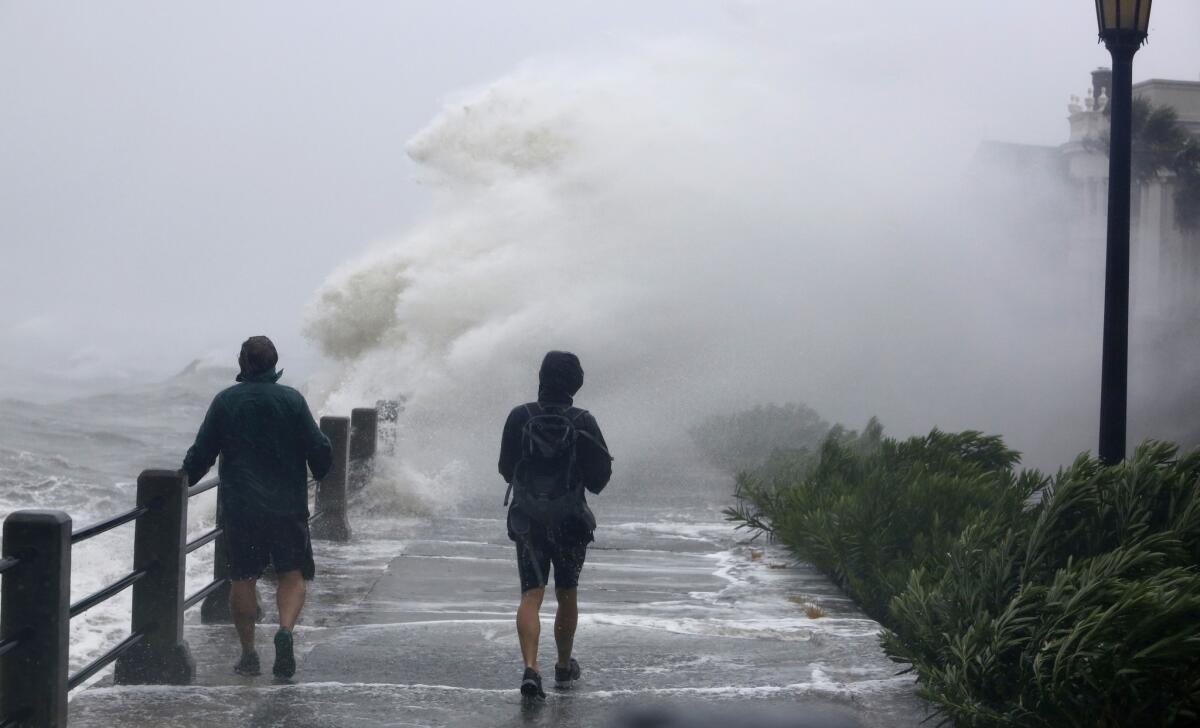
Authorities are reporting the first death in South Carolina related to Tropical Storm Irma.
Abbeville County Coroner Ronnie Ashley said Charles Saxon, 57, was cleaning debris outside his home in Calhoun Falls about 3 p.m. Monday when a tree limb fell on him.
Ashely said in a news release that Saxon died at the scene. An autopsy has been ordered.
The National Weather Service says winds in the area were gusting to about 40 mph at the time Saxon was killed. Calhoun Falls is 60 miles south of Greenville, S.C.
- Share via
‘It’s devastation’ in the Florida Keys, governor says

Florida Gov. Rick Scott says there is “devastation” in the Florida Keys, but the damage from Hurricane Irma was not as extensive on the state’s west coast as he had feared.
Scott told reporters that he flew over both areas on Monday and saw many overturned mobile homes and boats washed ashore in the Keys.
“My heart goes out to the people in the Keys,” he said at U.S. Coast Guard Air Station Miami. “It’s devastation, and I just hope everybody survived.”
As for the west coast of Florida, Scott said, “We clearly saw homes that were messed up, clearly saw roofs that were off.… But I thought we would see more damage.”
Going forward, he said the biggest threat would be from river flooding. Parts of the state are receiving torrential rains, which combined with the storm surge has caused historic flooding along the St. John’s River.
- Share via
Jacksonville hit with some of its worst flooding in 100 years
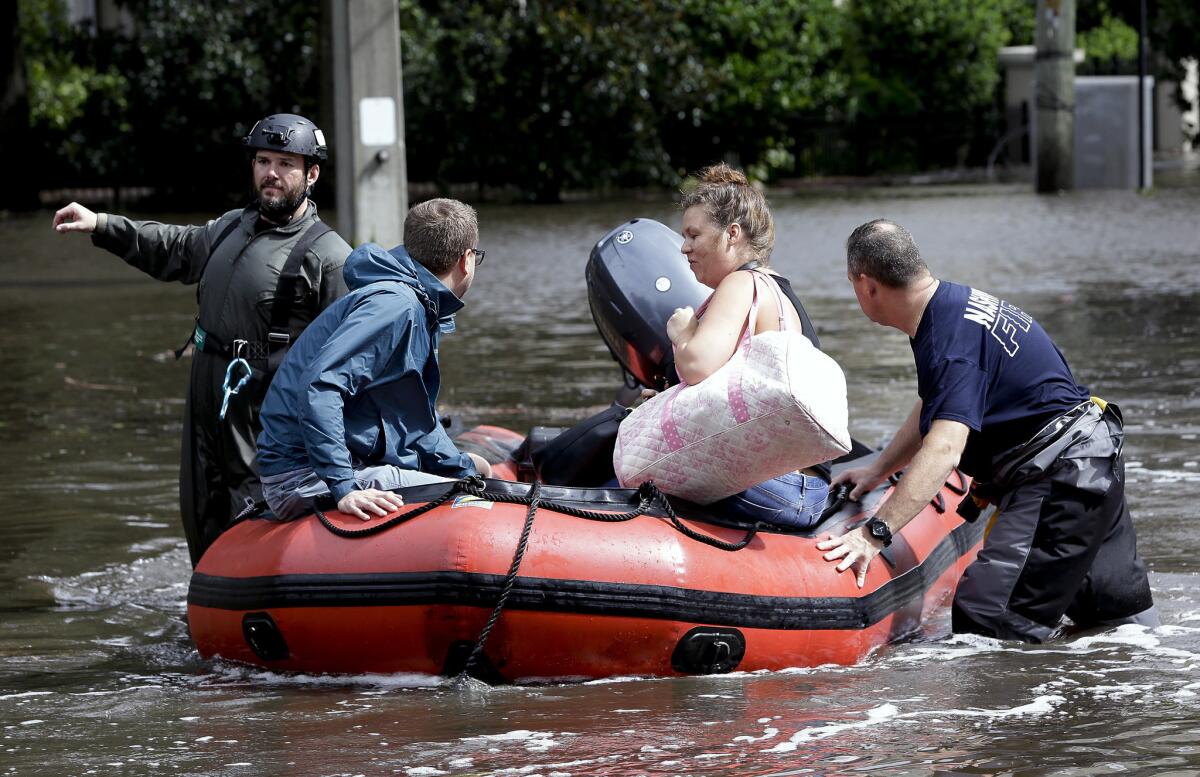
Jacksonville may have been spared the most ferocious winds of Tropical Storm Irma, but the torrential rains and storm surge have swelled the St. Johns River to historically high levels and inundated low-lying areas of the city.
Tom Bossert, the White House homeland security advisor, called it some of the worst flooding to hit the city in 100 years.
“Get out NOW,” the Jacksonville Sheriff’s Office warned people in evacuation zones. It advised those who needed help escaping flooded homes to visibly display something white – a shirt or a pillowcase.
Florida Gov. Rick Scott mentioned the gravity of the situation at his daily news briefing Monday.
“In Jacksonville,” he said, the “storm surge is 3 to 5 feet on top of more than a foot of rainfall, which is causing record and historical flooding along the St. Johns River.”
Scott said he spoke with Jacksonville Mayor Lenny Curry and assured him that resources were being deployed.
The state has sent teams from the State Emergency Operation Center and the Fish and Wildlife Commission to aid with search and rescue operations.
Curry said at least 100 people in the San Marco area had been rescued by midday.
Adding to the problems is that Hurricane Jose, which is churning in the Atlantic, is pushing water toward the northern part of the state and preventing water from receding from Jacksonville.
“They’re not going to recede today,” Curry said. “This is not a one-day event. This is probably a weeklong event.”
The National Weather Service called the flooding “a particularly dangerous situation.”
Sen. Marco Rubio (R-Fla.) tweeted words of encouragement to the city’s emergency responders. “Keep going, help is on the way,” he wrote.
The St. Johns River meanders through Florida for 310 miles, starting near Indian River County in the middle of the state and flowing north to Jacksonville, where it connects with the Atlantic.
- Share via
Irma death toll rises by three after an electrocution in Florida, two fatalities in Georgia
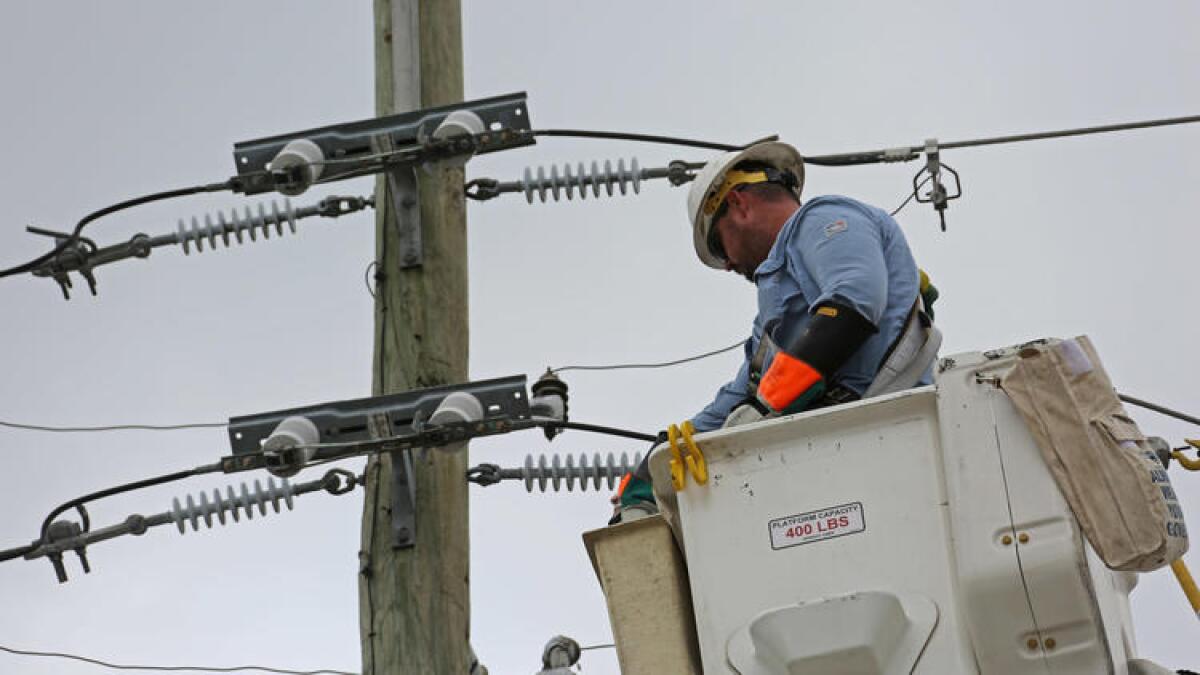
The death toll in Florida from Hurricane Irma grew by one Monday afternoon when a 51-year-old man in Winter Park, a suburb of Orlando, was found dead in the street after being electrocuted.
Officials in Georgia also confirmed two storm-related deaths, bringing the U.S. toll to at least eight, to go along with the 37 reported fatalities in the Caribbean.
Such tolls are difficult to determine because it is sometimes impossible to tell whether a death was the direct result of a storm.
At least four people died as a result of traffic accidents on Florida roads soaked by Irma.
A sheriff’s deputy and a corrections officer were killed in a two-car crash in Hardee County, southeast of Tampa, on Sunday morning.
A woman was killed in Orange County when the car she was driving struck a guard rail on Sunday.
And a man in Monroe County, near the Florida Keys, lost control of his truck, possibly because of high winds, and died.
In Miami-Dade County, a man died of carbon monoxide poisoning from his generator. This can happen if generators are used inside without proper ventilation.
Another storm-related fatality may have occurred in Shark Key, where a man was found dead in his home. But it’s not clear whether the death was related to first responders not being able to assist the man.
The Georgia Emergency Management Agency confirmed the storm-related deaths in Sandy Springs, a city north of Atlanta, and in Worth County, about 170 miles to the south. It provided no further details.
This post was updated with authorities confirming a second storm-related death in Georgia.
- Share via
French president headed to hurricane-devastated St. Martin and St. Barts

French President Emmanuel Macron will visit the Caribbean on Tuesday in an effort to persuade locals on the Hurricane Irma-devastated islands of St. Martin and St. Barts that Paris has not abandoned them.
Macron, whose popularity has plummeted at home, is taking flak from political opponents and islanders on the French territories for what they consider to have been inadequate hurricane preparations and a slow response to the mass destruction of homes and infrastructure.
He was traveling to St. Martin, a Franco-Dutch island, on an overnight flight aboard an Airbus carrying aid and emergency supplies. During his whistle-stop visit, he is also expected to travel to St. Barts, a French territory 20 miles to the southeast.
Fourteen people were killed on St. Martin -- 10 on the French side of the island, four on the Dutch side -- after Irma struck on Wednesday. Damage to the island is estimated at more than $1.65 billion by the French state-run reinsurance body, the CCR, which specializes in natural disasters.
- Share via
Tropical Storm Irma brings extensive flooding to Georgia coast
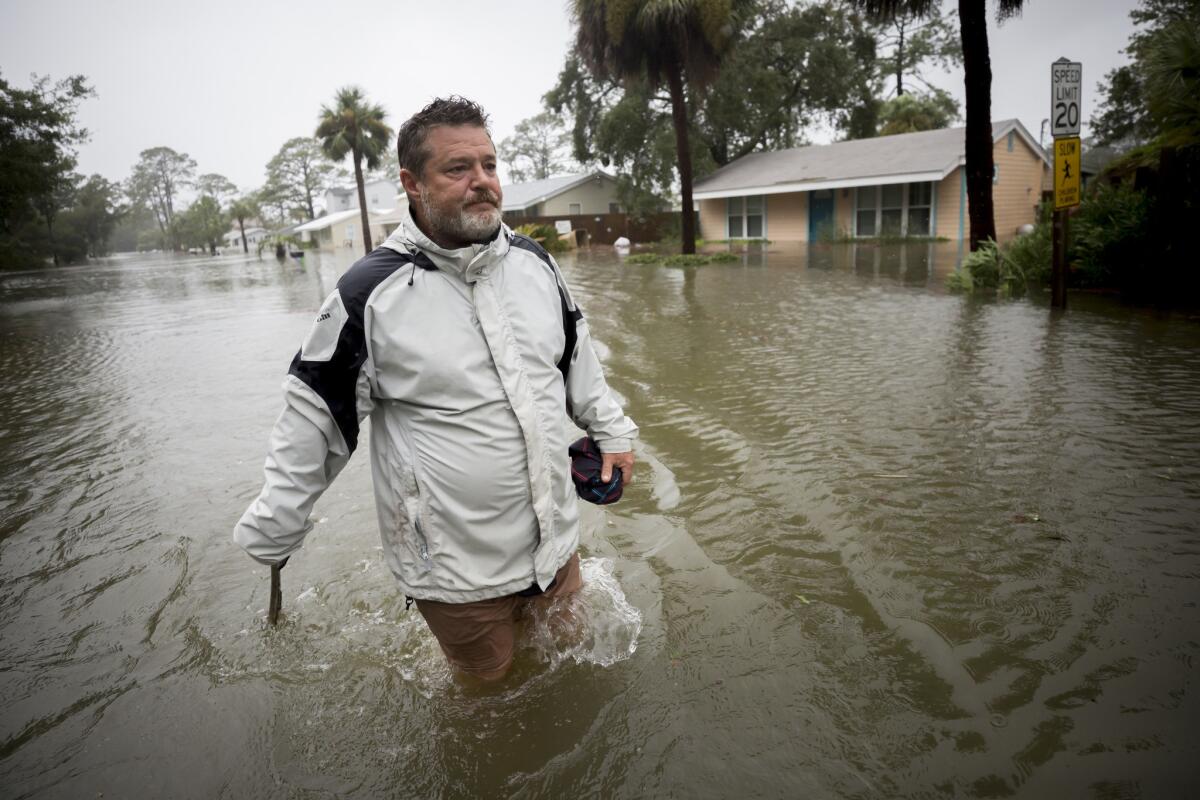
Communities along the Georgia coast are seeing extensive flooding from Tropical Storm Irma.
Irma’s storm surge pushed water ashore at the high tide Monday afternoon, and heavy rainfall made the flooding even worse.
On Tybee Island, east of Savannah, Hollard Zellers saw waist-deep water in the street as he went to fetch a kayak.
About 3,000 people live on Tybee Island, which is Georgia’s largest public beach. The city manager, Shawn Gillen, said the waters seemed to be receding quickly, but most of the island appeared to have some level of flooding, and there was water in many homes.
Storm surge also sent floodwaters into downtown St. Marys, just north of the Georgia-Florida line. St. Marys Police Lt. Shannon Brock said piers and boat docks were heavily damaged, and many boats sank.
- Share via
Frustrated Florida Keys residents wait for permission to return to evacuated homes
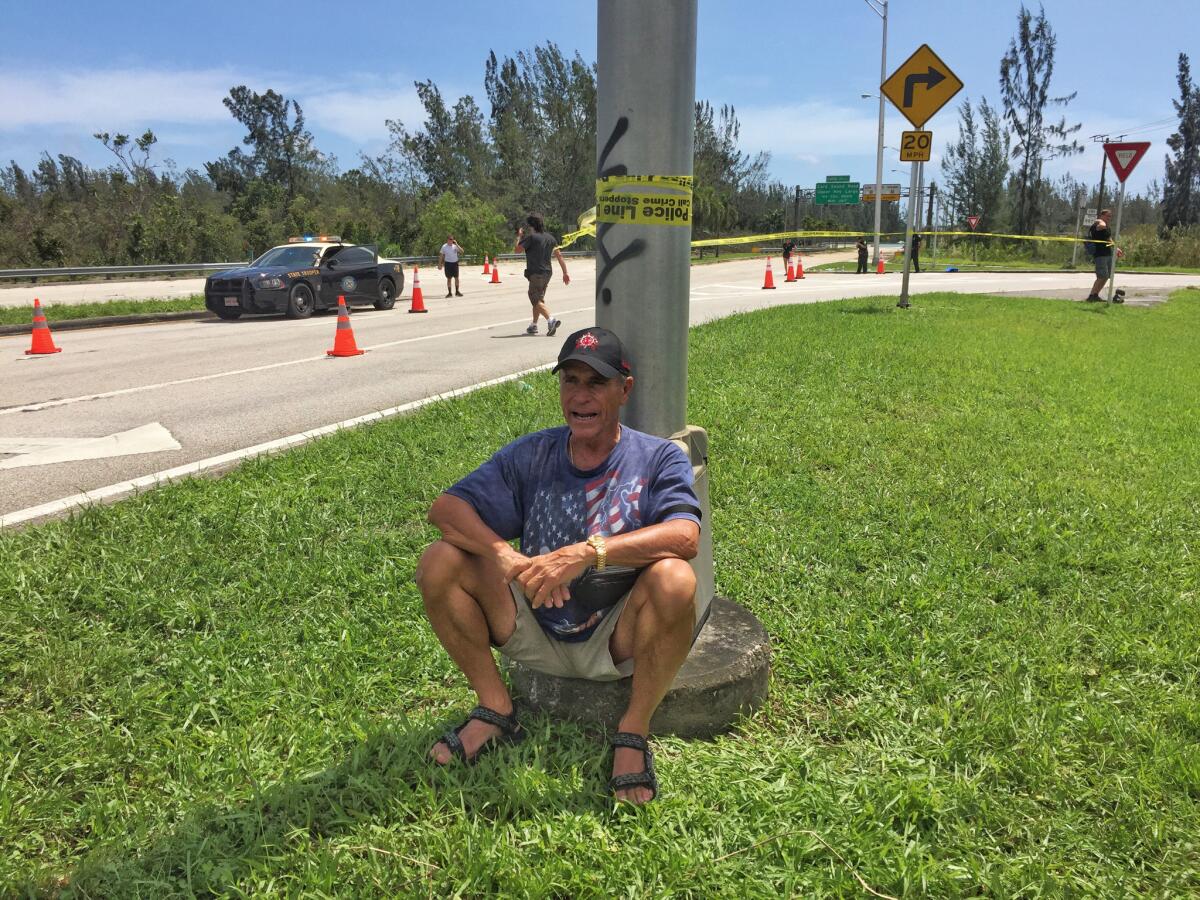
There is no gas at the RaceTrac gas station along Route 1 here, and the mini-market is shut down. The site is like a lot of other anonymous roadway establishments, featuring some palm trees, shrubbery and patches of grass across the road from a flooded thicket.
But the unremarkable petrol stop has become a terminus for stranded residents seeking to go back to their homes in the Florida Keys, as well as for dozens of journalists keen to survey the damage there in the wake of Hurricane Irma.
Florida authorities on Monday were stopping all southbound traffic here, a 20-minute drive or so from Key Largo. There is no other roadway south.
Frustration was mounting among those who want to go back home after obeying a mandatory evacuation order declared as Irma headed for Florida.
A dozen or so inhabitants of the Keys waited at the gas station, below a sweltering Florida sun, a day after the powerful stormed moved on. Joining them were a half dozen or so TV satellite trucks and other media vehicles.
“I’ve got a house full of food and water waiting for me back home, but they won’t let me through,” said Warren Stincer, a boat captain and carpenter from Key Largo who evacuated his home last week.
“I’m sorry I ever agreed to evacuate. Now I’m stuck here with no food and no water. My home is just 20 minutes down the road and I know the road is clear. I’m very disappointed with our officials.”
He had heard that his home wasn’t damaged in the storm.
“My house is fine, my boat is fine, the road is fine — everything’s OK,” said Stincer. “They just won’t let me back in.”
Joe Sanchez, spokesman for the Florida Highway Patrol, told reporters gathered here that the road would remain closed to all but emergency crews until authorities determined that it was safe.
Units of the Florida National Guard and other agencies have been dispatched to the Keys for the cleanup. Pickups ferrying bulldozers and other heavy equipment were being allowed through the police checkpoint.
“It’s a question of safety,” said Sanchez, addressing a gaggle of disappointed journalists. “There is debris in the roads. There is flooding. It’s just not safe yet.”
That was no consolation for Stincer and other residents of the Keys, including Odalis Padron, who was waiting on a grassy knoll at the edge of the gas station with her pet poodle, Taini. A tree and a rain umbrella provided some shade from the sweltering sun.
“People tell me the road is good, I don’t know why they won’t let us in,” said Padron, of Key West, expressing the general sense of frustration. “All we want to do is go home.”
- Share via
More than 10,000 U.S. service members are supporting relief efforts in Florida region
About 10,400 U.S. service members are supporting relief operations in the Florida region. The U.S. military says it has coordinated the evacuation of 1,904 people since Friday.
The Air Force is pre-positioning search and rescue units in Florida in Key West, Homestead Air Reserve Base, Patrick Air Force Base and Orlando to support state, local and national authorities.
The Air Force flew in about 300 doctors, nurses and healthcare professionals over the weekend to help issue relief aid.
The aircraft carrier Abraham Lincoln arrived off Florida’s east coast on Sunday night with 24 helicopters, and was prepared for operations in southern Florida and the Florida Keys on Monday morning. The amphibious assault ship Iwo Jima and amphibious transport dock ship New York also arrived.
- Share via
Central Florida starts its cleanup after Hurricane Irma
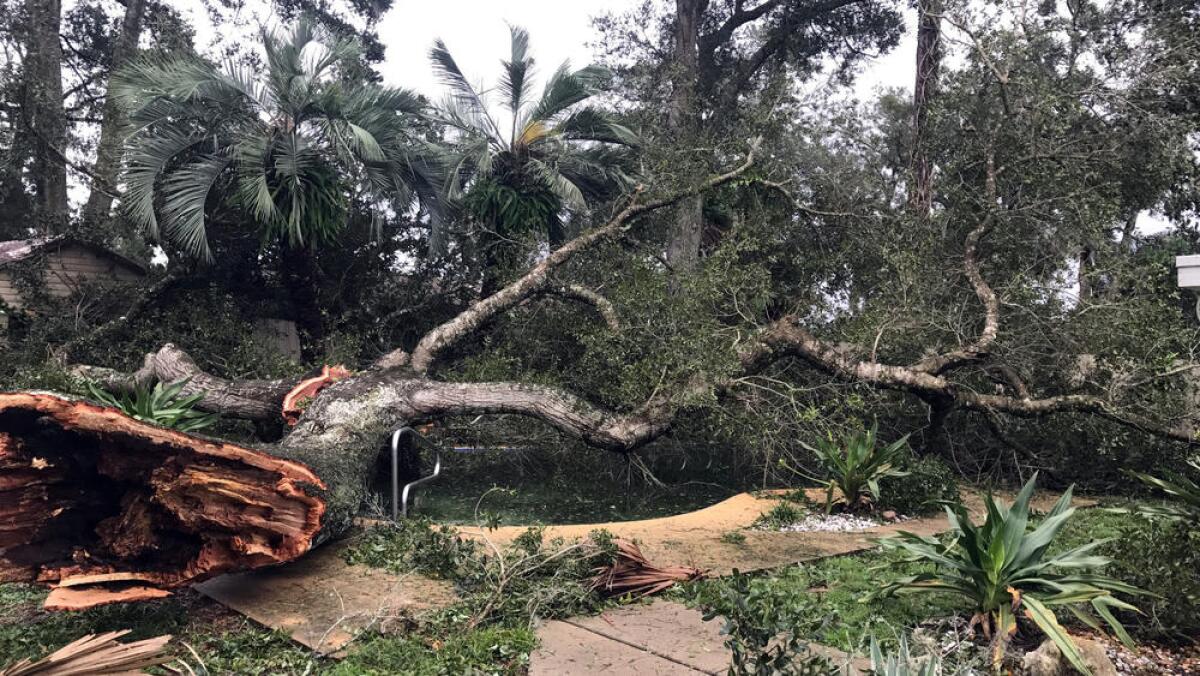
The morning after Hurricane Irma rumbled through central Florida with howling winds and torrential rain, the region was working to clean up damage that mostly amounted to downed trees and power lines and some flooding.
There was hardly a neighborhood in this vast tourist corridor that did not have upended trees and no power. More than half a million people were without power.
Winds blowing at 30 to 40 mph were hampering the cleanup effort, although in many neighborhoods people were out with rakes and power saws.
“I’m so proud of the people of Orlando for taking Irma seriously,” the city’s mayor, Buddy Dyer, said at a news briefing. “This morning I was out in many of the neighborhoods in our city and was pleased to see neighbors out helping other neighbors clean up yard debris and clear trees from yards.”
Overall the damage was much less than it could have been. There were one reported storm-related death, a traffic fatality on a toll road on Sunday.
Seminole County, a collar county around Orlando, lifted its curfew at 11 a.m. Orange County still has a curfew in effect until 6 p.m.
The major theme parks of Disney World, Universal and SeaWorld are all going to try to open on Tuesday. SeaWorld reported that all its animals and personnel were safe.
Stormwaters flooded a neighborhood of 24 homes south of Pine Hills. But the National Guard, in some cases using boats because the water was too deep for their vehicles, rescued all the residents without any reported injuries. The waters were as deep as three feet, but have already started to recede, and residents are expected to return to their homes Monday to assess damage.
Other areas of low-lying Orange County also reported flooding, although no injuries were reported. Some parts of central Florida had as much as 10 inches of rain.
A large sinkhole was reported in east Orlando and a few small ones have also occurred, making some roads difficult to drive.
Many lift stations in Seminole County were damaged, and residents were asked to limit their use of showers, laundry and flushing toilets until the stations were fixed.
- Share via
Hurricane Irma cuts power to more than 7 million homes and businesses
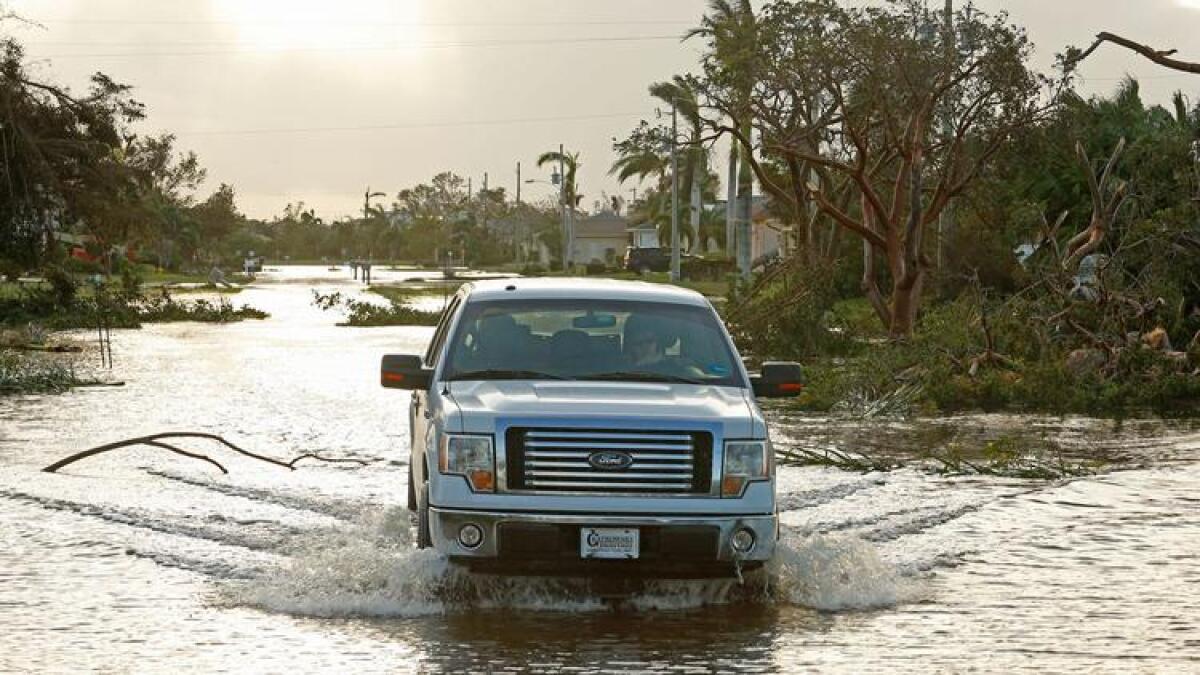
Nearly 7.2 million homes and businesses are without power in multiple states as Tropical Storm Irma moves through the Southeast.
The vast majority are in Florida. The state’s emergency management officials said the storm had cut power to more than 6.5 million account holders across the state as of Monday afternoon.
Eric Silagy, chief executive of Florida Power & Light, said Irma caused the most widespread damage in the company’s history. It affected all 35 counties in the utility’s territory, which is most of the state’s Atlantic coast and the Gulf coast south of Tampa.
The most extensive damage was likely in the Naples area, but a full assessment was ongoing. He said 19,500 electric workers have been deployed in the restoration effort.
Still, he said, it will take days for many people to be restored and, in some cases where the damage was extensive, weeks.
Meanwhile, Duke Energy reported Monday morning that more than 860,000 of the homes and businesses it serves in Florida were without power.
Georgia reported more than 570,000 homes and businesses without electricity, and there were 80,000 in South Carolina.
This post has been updated with more than 7 million homes and businesses without power in multiple states
- Share via
In Bonita Springs, waist-deep polluted water flows through houses hit by Hurricane Irma
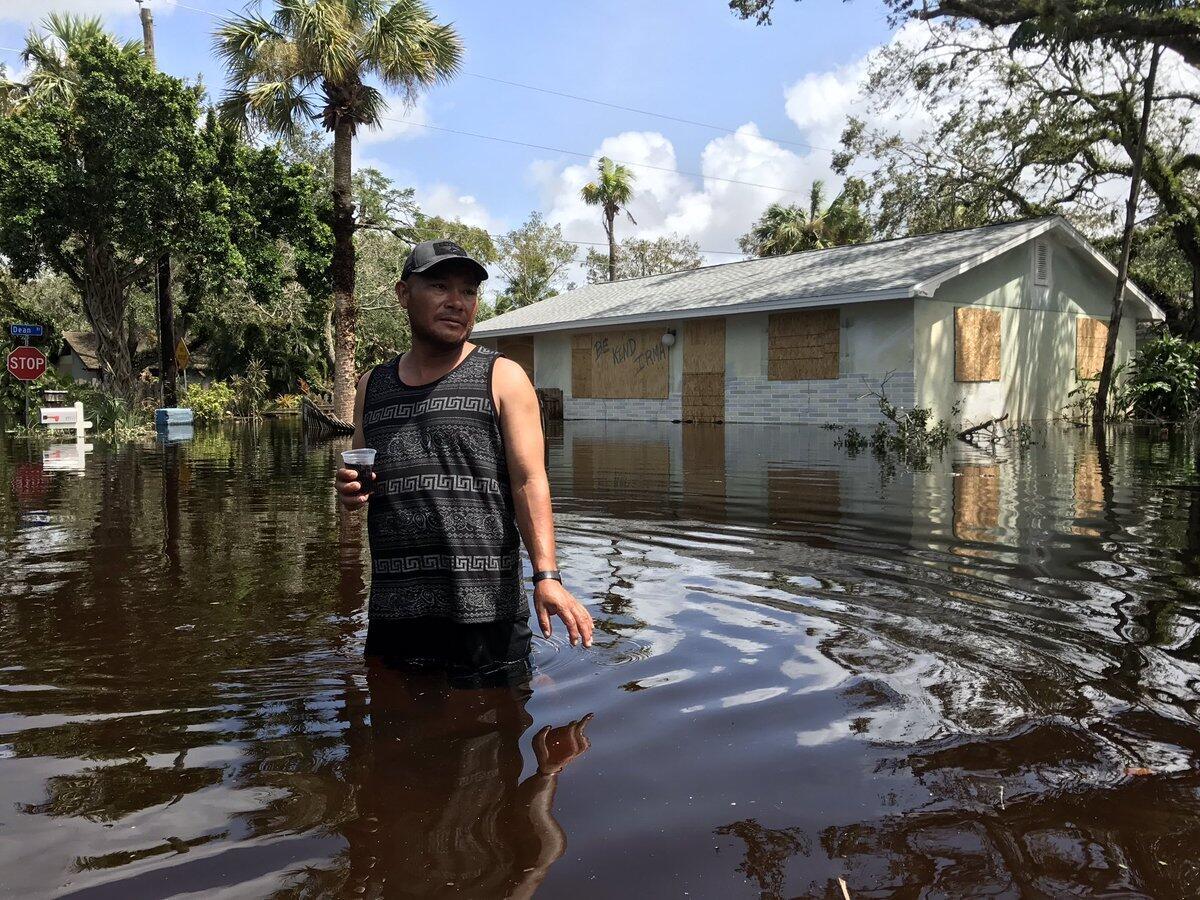
Some of the Floridians hardest hit by Irma live in a modest residential neighborhood near the river in Bonita Springs, where waist-deep polluted water flows through their houses.
But that isn’t keeping some of them from staying put. As a members of a rescue team cruise the flooded streets in a motorized raft, they say they are finding residents trapped in their homes who have no interest in leaving. The residents were determined to see the hurricane through in their homes, and now they are determined to stay in them until they are fully habitable again.
Some found their way onto plastic boats. Others pushed away debris such as nearly fully submerged garbage cans bobbing along the streets.
It could be a week before the massive pond of sewage-tainted storm water engulfing their properties recedes.
“They are happy stuck in their houses. They are saying, ‘We have enough food and water, we are going to be fine,’” said Lt. Manny Hernandez of the Bonita Springs Fire Control & Rescue District.
The rescuers have been knocking on every door in the neighborhood as they float by. Some residents take up the offer and leave their homes, but others say, no, thank you.
Hernandez said he figured there were about a dozen people in homes inundated with waste-deep water. How many of them called for a rescue once the storm passed? Zero, he said.
The neighborhood is a wreck right now, and there are others like it nearby. Yet locals are surprised to see how few communities look that way. Forecasters predicted many, many more homes would be destroyed.
Even right across the beach in downtown Naples, where devastation was forecast, tony beach homes endured the storm with just a few scrapes and no serious water damage.
“The damage hasn’t been as bad as I expected,” said Hernandez as he waited for the rescue raft to get back from its rounds.
- Share via
There’s still flooding in Naples. But the birds are drying their feathers
- Share via
Disney World may not reopen until Tuesday as Hurricane Irma damage assessment continues
Even though Hurricane Irma has passed through central Florida, Orlando’s theme parks — including all four at Walt Disney World — may not reopen until Tuesday.
All major attractions were closed Sunday and Monday as the storm worked its way up the length of the state.
Tropical-storm-force winds are expected to linger well into the afternoon, and Orlando is under a curfew until 6 p.m. Monday.
“We are beginning an initial assessment of our property,” a Disney World spokeswoman said Monday morning. “While we experienced high winds and rain, we maintained power throughout the storm.”
Disney decided on Friday it would close Magic Kingdom, Epcot, Disney’s Hollywood Studios and Disney’s Animal Kingdom parks for two days. Its Disney Springs shopping and entertainment complex is also closed. The company’s hotels stayed open to guests.
Disney closures are rare. This one is the fifth since the Florida resort opened in 1971.
- Share via
In a Naples mobile home park, neighbors count their blessings
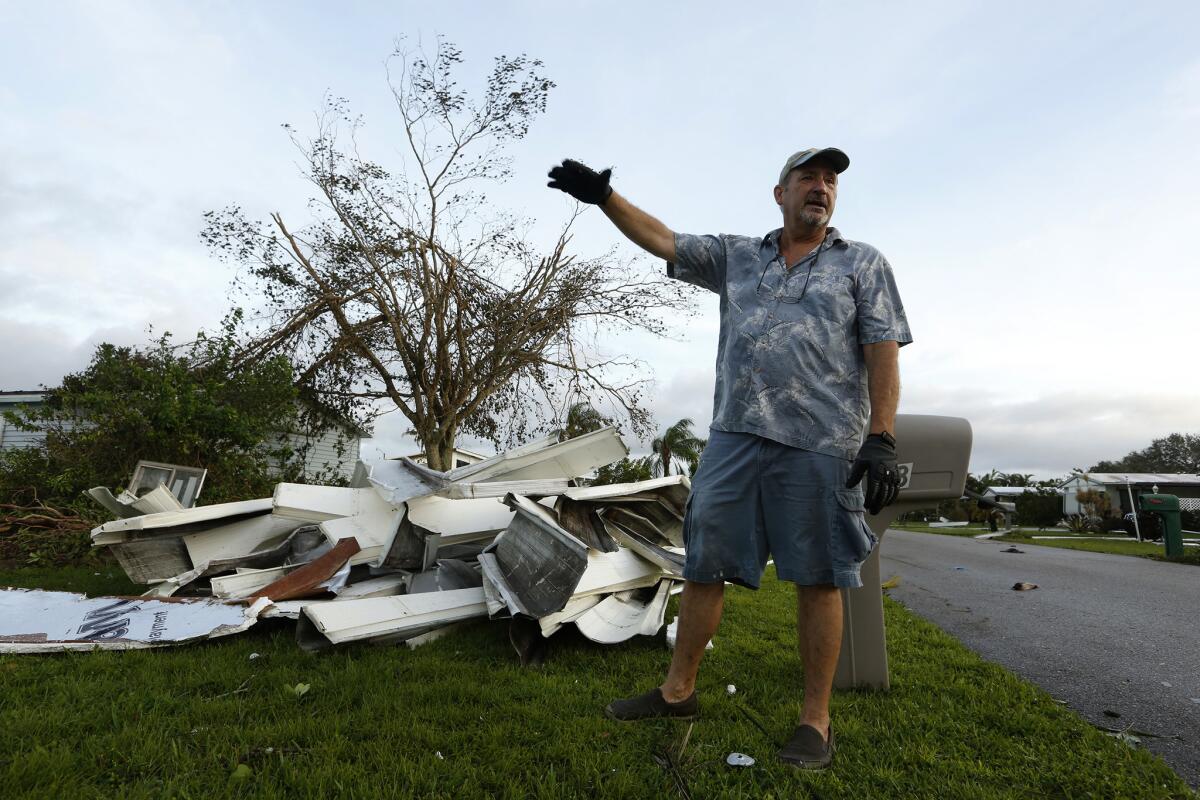
Terry Thompson moved into his home in the Riverwood Estates Mobile Home Park in Naples two weeks ago. Remarkably, it was still there on Monday.
“There’s a lot of cleanup,” the 65-year-old Air Force veteran said as he assessed the situation around his home. Though it was intact, his neighbor’s carport had flown off and smacked into his wife’s car. Siding had blown off the house. Water still covered many of the streets. Debris was everywhere.
Thompson said he rode out the storm with his dog in the mobile home.
“It was wild. ... The house was lifting and moving and shifting. All sorts of things were going on,” he said.
John Jenkins, 52, also lives in a brand new mobile home in Riverwood Estates. The street in front of the house was still underwater Monday morning, but his house was standing and mostly intact — which couldn’t be said for all his neighbors’ homes.
During the storm, he said, he went our twice and had to take aluminum sheets that were prying loose from his neighbor’s carport and get them out of the path of his house.
“It was quite interesting,” he said. “Their carport was peeling apart and coming at our house. ... I was worried about all the debris.”
A friend drove by and Jenkins reached in the driver’s side window and gave him a hug. “I love you,” he said. He asked if the friend was OK. The friend reported that his house was fine.
The stakes were particularly high for Jenkins, who couldn’t get the bank to fund a loan for his home. “I put everything I got in the world into [buying] it,” he said.
- Share via
Irma heads to Georgia after some in Florida say they dodged a catastrophe
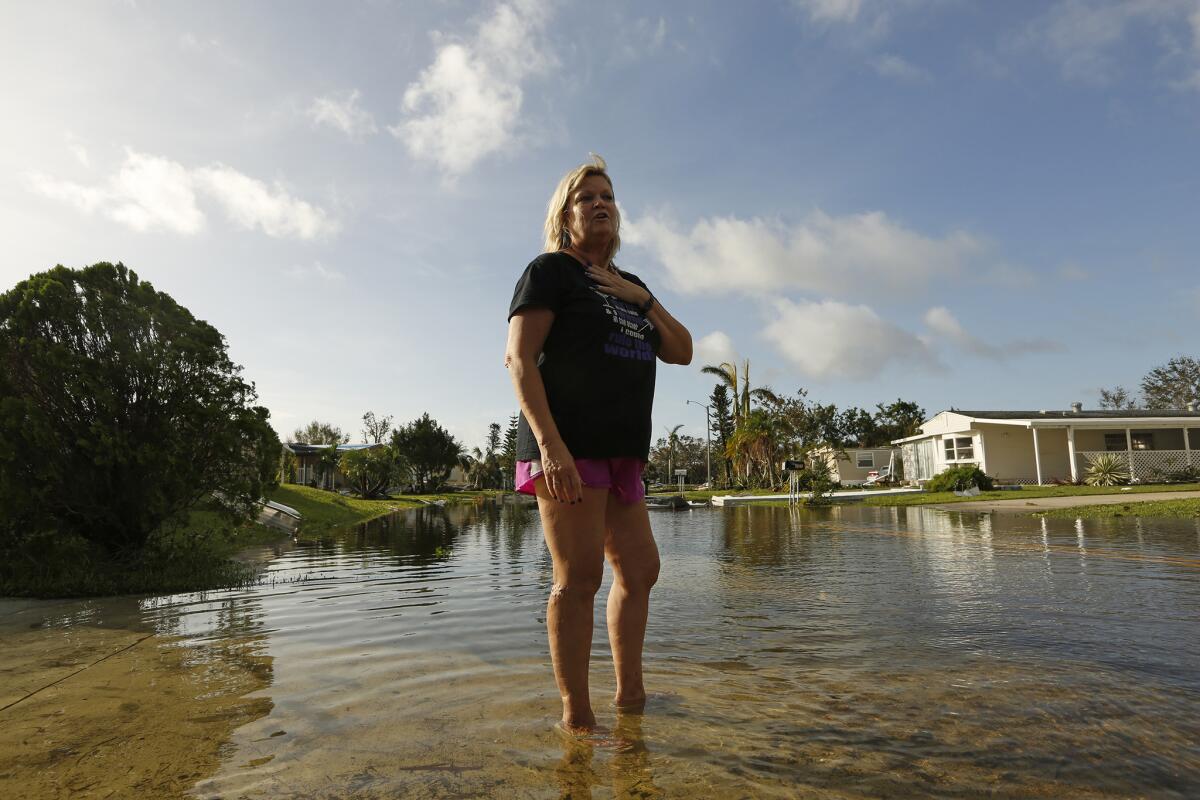
Florida awakened to a debris-pocked panorama, with millions lacking electricity in steamy heat as Irma — now downgraded to a tropical storm — took a parting swipe at a band of north Florida and aimed for Georgia.
As the storm passed, the danger lingered: Storm surges jeopardized cities along Florida’s Gulf and Atlantic coasts, and the National Hurricane Center said Irma was still producing some hurricane-force wind gusts after spinning off tornadoes in the state’s central core.
Although the storm’s raging winds and punishing rains lent it an apocalyptic feel as it unfolded, initial damage assessments appeared significant and widespread, but short of catastrophic.
By 8 a.m. Monday, the storm, still remarkably wide in its radius, had moved about 105 miles north of Tampa, which along with St. Petersburg was spared a direct hit the night before, with the storm passing to their east through inland counties.
- Share via
Irma weakens to a tropical storm, but winds remain near hurricane force
A weakened but still dangerous Irma pushed inland Monday as it hammered Florida with winds and floodwaters that created hazards even for rescuers trying to help beleaguered residents.
Irma was downgraded to a tropical storm over Florida, but it still had winds near hurricane force. Its outer bands were also blowing into Georgia, where the storm’s center was expected to arrive later in the day. With rough conditions persisting across Florida, many communities in Irma’s wake feared what destruction would be revealed when daylight came.
Winds knocked a utility pole and power lines onto a sheriff’s cruiser late Sunday in Polk County east of Tampa, illustrating the dangerous conditions for emergency personnel. A deputy and a paramedic, who had just escorted an elderly patient to safety, were trapped for two hours until a crew could free them. Both were unhurt.
More than 120 homes were being evacuated early Monday in Orange County, just outside the city of Orlando, as floodwaters started to pour in. Firefighters and the National Guard were going door to door and using boats to ferry families to safety. A few miles away, 30 others had to be evacuated when a 60-foot sinkhole opened up under an apartment building. No injuries were reported in either case.
In Redington Shores west of Tampa, attorney Carl Roberts spent a sleepless night riding out Irma in his 17th floor beachfront condo. After losing power late Sunday, he made it through the worst of the storm shaken but unhurt.
“The hurricane winds lashed the shutters violently, throughout the night,” he wrote in a text message, “making sleep impossible.”
As morning broke, he couldn’t open the electric shutters to see outside.
“It’s so dark in here,” he said.
Nearly 4.5 million homes and businesses across Florida lost power, and utility officials said it will take weeks to restore electricity to everyone. More than 100,000 were in the dark in Georgia.
Irma’s center was about 105 miles north of Tampa when forecasters announced it had weakened to a tropical storm. However, they warned its maximum sustained winds were 70 mph and that the storm was still producing higher gusts.
The monster storm, which arrived in Florida as a Category 4 hurricane, has toppled at least three construction cranes — two over downtown Miami and one in Fort Lauderdale.
People in the heavily populated Tampa-St. Petersburg area had feared a first direct hit from a major hurricane since 1921, but the storm weakened to a Category 2 as it approached that area.
Tampa Mayor Bob Buckhorn said the situation was not as bad as it could have been, but warned residents that a dangerous storm surge continued. He also described downed power lines and other debris.
“What we feared the most was the surge,” he said in an interview on MSNBC. “The surge is yet to be finished.”
Meanwhile, rescue efforts ramped up in the evacuated neighborhood near Orlando as National Guardsmen in helmets and fatigues rolled through standing water in a high-clearance vehicle. Firefighters rescued a puppy from one of the homes there and leashed the anxious dog to the front of one of their trucks to give it water and snacks.
As the sun rose in Orlando, many tried to survey the damage, but authorities warned that conditions remain dangerous and asked people not to venture outside because of a curfew.
No deaths in Florida were immediately linked to the storm. In the Caribbean, at least 24 were people were killed during Irma’s destructive trek across exclusive islands known as the vacation playground for the rich.
In one of the largest U.S. evacuations, nearly 7 million people in the Southeast were warned to seek shelter, including 6.4 million in Florida alone. More than 200,000 people waited in shelters across Florida.
Next, Irma is expected to push into Georgia, Alabama, Mississippi, Tennessee and beyond. A tropical storm warning was issued for the first time ever in Atlanta, where many schools canceled classes.
Bryan Koon, Florida’s emergency management director, said late Sunday that authorities had only scattered information about damage.
“I’ve not heard of catastrophic damage. It doesn’t mean it doesn’t exist. It means it hasn’t gotten to us yet,” Koon said.
In the low-lying Keys, appliances and furniture were seen floating away, and Monroe County spokeswoman Cammy Clark said the ocean waters were filled with navigation hazards, including sunken boats.
The county administrator, Roman Gastesi, said crews would begin house-to-house searches Monday morning to check on survivors.
About 30,000 people heeded orders to leave the Keys as the storm closed in, but an untold number refused, in part because, to many storm-hardened residents, staying behind in the face of danger is a point of pride.
John Huston, who stayed in his Key Largo home, watched his yard flood even before the arrival of high tide.
“Small boats floating down the street next to furniture and refrigerators. Very noisy,” he said by text message. “Shingles are coming off.”
Irma once was the most powerful hurricane ever recorded in the open Atlantic, a Category 5 with a peak wind speed of 185 mph. For days, forecasters had warned Irma was taking dead aim at Florida. Irma made landfall as a Category 4 hurricane Sunday morning at Cudjoe Key, not far from Key West. It then rounded Florida’s southwestern corner and hugged the coast closely as it pushed north.
- Share via
Nearly 4.5 million without power in Florida
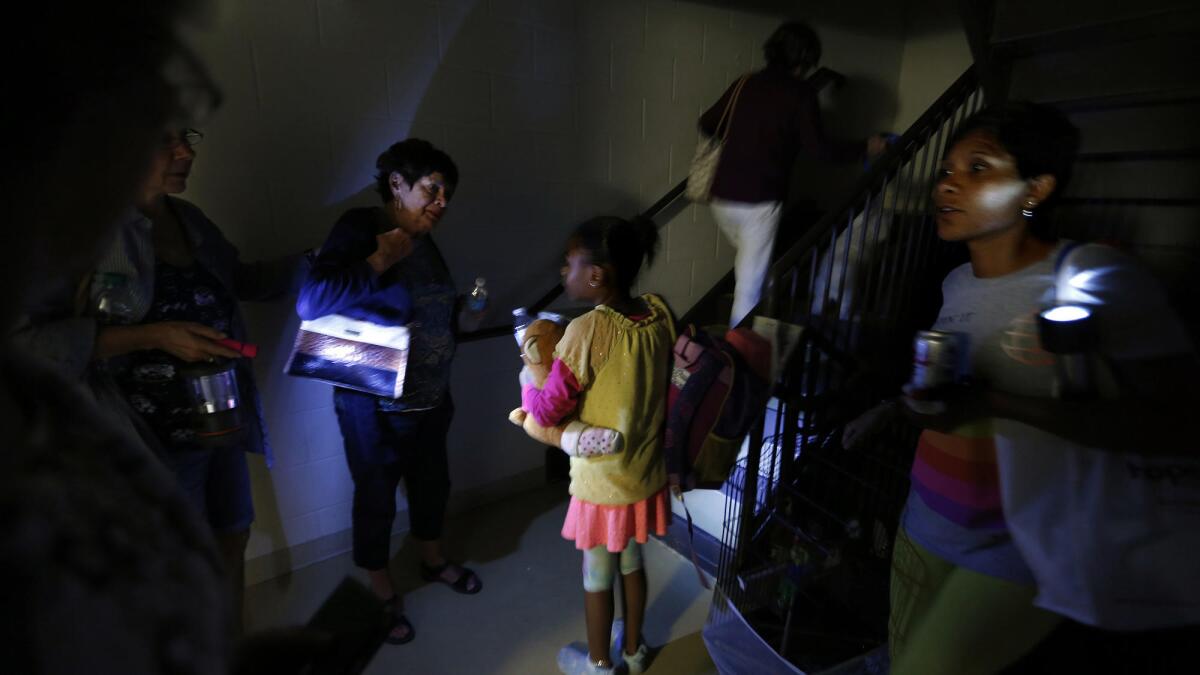
Nearly 4.5 million homes and businesses across Florida have lost power as Hurricane Irma moves over the state.
Utility officials say it will take weeks to restore electricity to everyone. Farther north, more than 100,000 are in the dark in Georgia.
Much of eastern Alabama and coastal South Carolina are under tropical storm warnings as Irma pummels Florida, weakening on its march northward.
The National Hurricane Center predicts the storm will cross Monday into southwest Georgia, where a hurricane warning was in effect for a large rural area including the cities of Albany and Valdosta.
Rain was falling in parts of the state, including metro Atlanta, early Monday.
- Share via
Irma’s winds slightly weaken as the storm moves further north
Hurricane Irma’s maximum sustained winds slightly dropped to 75 mph as it made its way across central Florida and headed north early Monday, the National Hurricane Center said.
The storm weakened to Category 1 late Sunday — its maximum sustained winds were at 85 mph then. The National Hurricane Center said it expects the storm to weaken to a tropical depression by Tuesday afternoon.
Storm surge warnings remained in effect for parts of the coasts of Florida, Georgia and South Carolina.
- Share via
Irma weakens to Category 1 storm as it pushes north of Tampa
Irma has weakened to a Category 1 storm as it continues to push north through central Florida, the National Hurricane Center said.
The eye of the storm is now 25 miles northeast of Tampa, and its maximum sustained winds have slowed to 85 mph. The hurricane was expected to decrease to a tropical storm later Monday.
Still, hurricane-force winds were extending 80 miles from the storm center, and tropical storm-force winds up to 415 miles from the eye.
Wind gusts of hurricane force have recently been reported at Orlando International Airport, the hurricane center said.
The storm has ravaged through Florida since early Sunday, ripping roofs from homes, flooding neighborhoods and cutting power to thousands of homes.
- Share via
Hurricane Irma aims its fury at central Florida, moving east of Tampa Bay
Hurricane Irma, after making an unexpected turn to the north-northeast, continued its march up the state Sunday night, this time heading for central Florida. The eye of the storm is about 50 miles east of Tampa Bay, and it is expected to cross over the greater Orlando area between 2 a.m. and 4 a.m.
The 11 p.m. National Hurricane Center advisory has the storm heading north before turning slightly back toward the northwest once it crosses through the west Orlando area. Some models have the storm crossing the line between Lake and Orange counties, slightly west of Orlando, before its expected turn back through Marion County and the city of Ocala.
But one thing that has become clear about Irma in the last few days is that it doesn’t always do what it is expected to do.
The sudden turn spared Tampa a greater impact but put the tourist corridor in Orlando directly in the storm’s crosshairs. From a practical standpoint, the more time the storm stays over land, the quicker it will weaken. And Orlando, 35 miles inland, does not face threats from storm surge.
Wind gusts are expected to be in the 80 to 100 mph range. Minimal hurricane force wind gusts of 75 mph have already been reported at Orlando International Airport earlier Sunday.
Central Florida was beset by tornados earlier in the day. Twisters damaged 18 mobile homes in Brevard County, home of the space program, without any injuries. A motorist in Orange County was killed when her car hit a guard rail.
Already 5 to 6 inches of rain have fallen, more in some areas. The storm has toppled trees and caused massive power outages throughout the area. Flash flood warnings have been issued in low-lying areas.
As the storm approaches, the risk of tornados grows less as even those severe wind funnels can’t survive in the high winds of a hurricane.
UPDATE 9:23 p.m.: The post was updated with Irma’s latest location.
- Share via
Stranded by Irma, manatees get rescued by bystanders and deputies
As coastal Florida residents discovered Sunday, one of the strangest side effects of Hurricane Irma was the way the storm drained seawaters away from shorelines, leaving huge mud flats behind where water used to be.
That wasn’t the only unusual discovery.
In the partially drained Sarasota Bay, south of Tampa, residents spotted a pair of brown lumps out in the muddy flats.
They were manatees, the peaceful, lumbering aquatic mammals that frequent Florida’s waters. They had gotten caught out of the water because of the storm.
“We had to do something about it,” Tony Faradini-Campos of Sarasota told the Sarasota Herald-Tribune. “We couldn’t just let those manatees die out there. We shared the pictures on social media and it just blew up.”
Two sheriff’s deputies from Manatee County -- yes, that’s right -- came to help.
“They put some tarps under the manatees and they kind of used that as a luge and got him back out there,” Faradini-Campos told the newspaper. “I was a little scared that the tide was going to come in. We were advised just to get out of the bay for our safety” before the storm waters came rushing back in.
Faradini-Campos wrote on Facebook that the manatees were successfully moved to deeper water.
Manatees are aquatic mammals and breathe air. Adult manatees can weigh 1,000 to 3,500 pounds.
Manatees are protected under federal and Florida law, which states that “it is unlawful for any person, at any time, intentionally or negligently, to annoy, molest, harass or disturb any manatee.” They were recently downgraded from “endangered” to “threatened” species status.
The Florida Department of Fish and Wildlife did not immediately respond to a request for comment Sunday evening.
- Share via
As evening falls, Miami residents start to peek outside
As night fell Sunday on Miami, the winds, while still fierce, had diminished to the point where it was possible to stand outside without tumbling over.
The rain that had fallen in horizontal sheets since the pre-dawn hours had ceased. Some vehicles were seen traversing streets littered with branches, pieces of road signs and other detritus from the storm. Branches and other debris still flew in the air.
A few people ventured outside, some with dogs seemingly relieved to be in the fresh air after being cooped inside for so long. The sky was clearing and lights were on in many of the downtown towers, an indication perhaps that progress was was being made in restoring power to the many left in the dark as Irma plowed through the state.
With most street lights and intersection signals out, drivers ignored red lights, sometimes using common sense, sometimes not.
A block from the Biscayne Boulevard waterfront, the wealthier of downtown residents were walking their well-groomed dogs and taking pictures of debris.
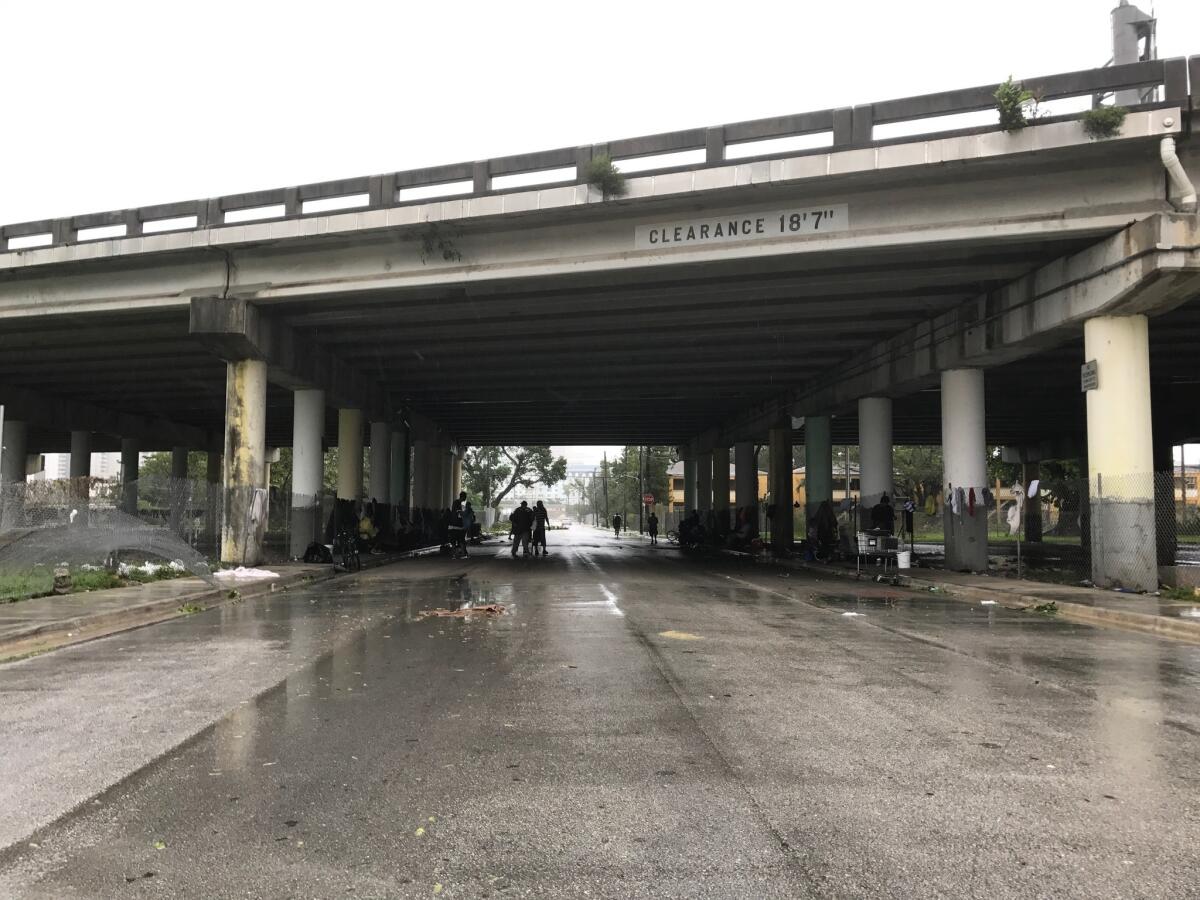
A dozen blocks east of there, groups of homeless people were huddled under bridges and highways. Some parked cars had windows blown out.
The wind still howled, but nothing like the thunderous roar that had shaken the city since the pre-dawn hours.
UPDATE 6:33 p.m.: The post was updated with additional scenes from Miami.
- Share via
Video: Miami’s crowded Brickell neighborhood spent part of the day as a river
- Share via
When a hurricane takes out the power, light becomes too precious not to share
- Share via
Sloshing through water after Irma’s floods for a glimpse of home: Is it still there?
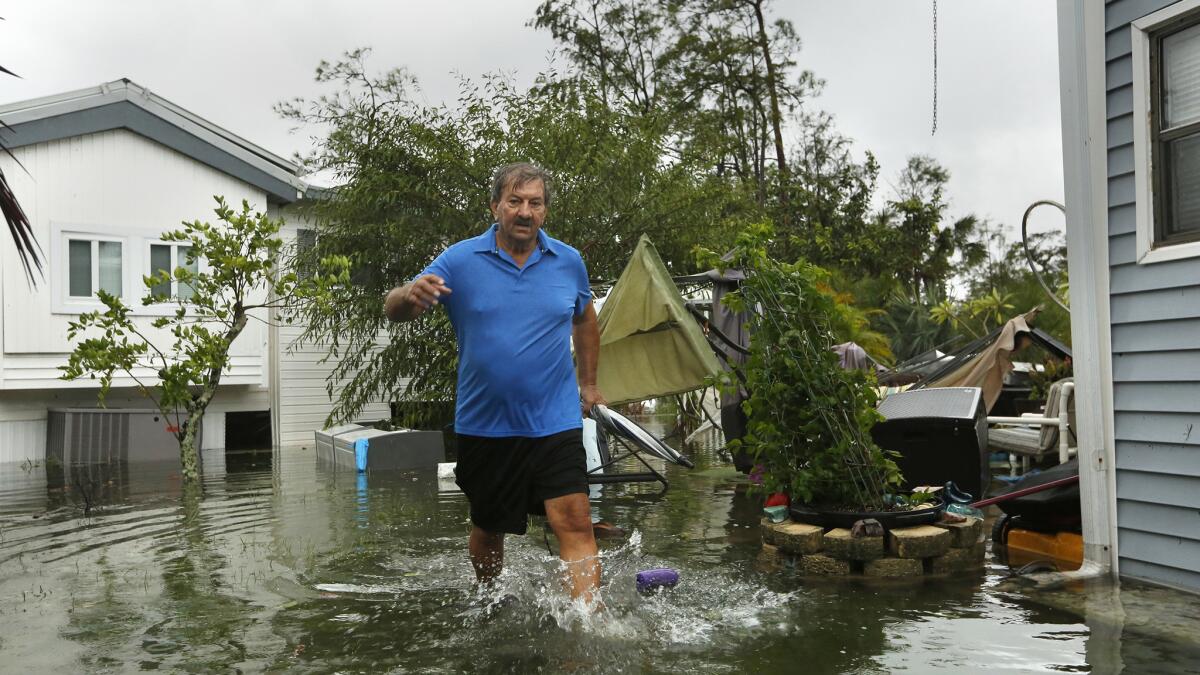
When the eye of the storm settled over the Fort Myers, Fla., area, John Krowzow had a secret plan.
The 74-year-old would embark on a mission with his 82-year-old buddy, Don Fetters, to go check out their mobile homes in the town of Estero. Krowzow would be keeping that secret from his wife.
The eye’s calm is fleeting. Krowzow had to drive 15 minutes from the house where he was staying through the storm to get to his unit. But evacuees holed up in shelters, hotels and the homes of friends are anxious to see what has become of their houses.
Fetters arrived to a grim scene. The 640-unit Corkscrew Woodlands mobile home park for seniors was gushing with water. At least 3 feet of it. His car could not even make it to his mobile home. But Fetters persisted. He hitched a ride in a passing journalist’s SUV.
But thank heavens for cinder blocks. The water had gushed under, rather than through, Krowzow’s home. It was his birthday earlier this month, and Krowzow said the discovery of his home intact was a welcome present. “I feel good,” he said. Some others at the park were in worse shape. “My neighbor’s roof blew off… There are a lot of homes not damaged. But a few have a lot of damage.”
- Share via
Sporadic burglaries during Irma evacuations, police say
With millions of people under evacuation advisories, thieves are taking advantage of the homes emptied during Hurricane Irma.
The Sun Sentinel documents several such cases, though the phenomenon does not appear to be widespread:
— Two 17-year-olds burglarized a home in Weston, Fla., and a deputy shot one of them, authorities said. The owners of the home were out of the country, but they spotted a burglary in progress on their home security cameras and called the Broward Sheriff’s Office. Deputies shot Dylan Lemon of Weston outside the home about 3 a.m. Sunday and arrested Jean Coello, also of Weston.
— Two burglars broke into six Fort Lauderdale homes overnight Saturday into Sunday. Ryan Cook and Max Saintvil, both 28, face six counts each of burglary, said Casey Liening, a spokeswoman for Fort Lauderdale police.
— Nine people were arrested Sunday afternoon and accused of looting in Fort Lauderdale. Television news video showed people clambering in and out of a jagged hole in a shattered window, snatching sneakers and clothing from a sportswear store. A block away, they pilfered what they could from Cash America Pawn, police said.
- Share via
Inside an Orlando homeless shelter where families are waiting out the storm
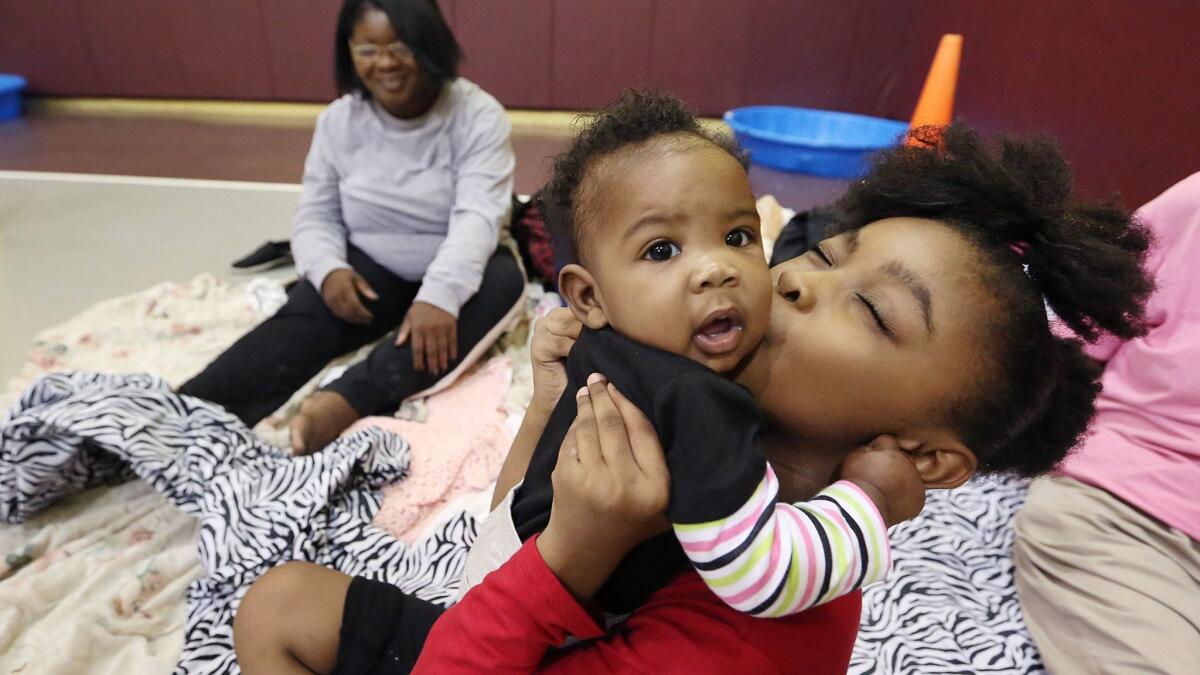
Hurricane Irma was still a weather-map swirl near Cuba when 8-year-old Jelisiyonia Mays bounded across the gym at the Orlando Union Rescue Mission.
“Hello!” she offered brightly as each new person entered her temporary home away from home. “I drank too much tea with a whole bunch of sugar! I might go crazy!”
Her mother, Michelle Mays, 35, had spent half of last week watching the news nervously. Though her family wasn’t homeless, as were some of the people sharing the mission’s gym during the storm, she didn’t trust her mother’s Carver Shores home to weather a major hurricane well.
“This one scared me,” Mays said. “And I don’t scare easily.”
- Share via
Storm surge hits Miami
- Share via
Weather reporter rides the wind
- Share via
You’ve heard a lot about storm surge. What is it, exactly?
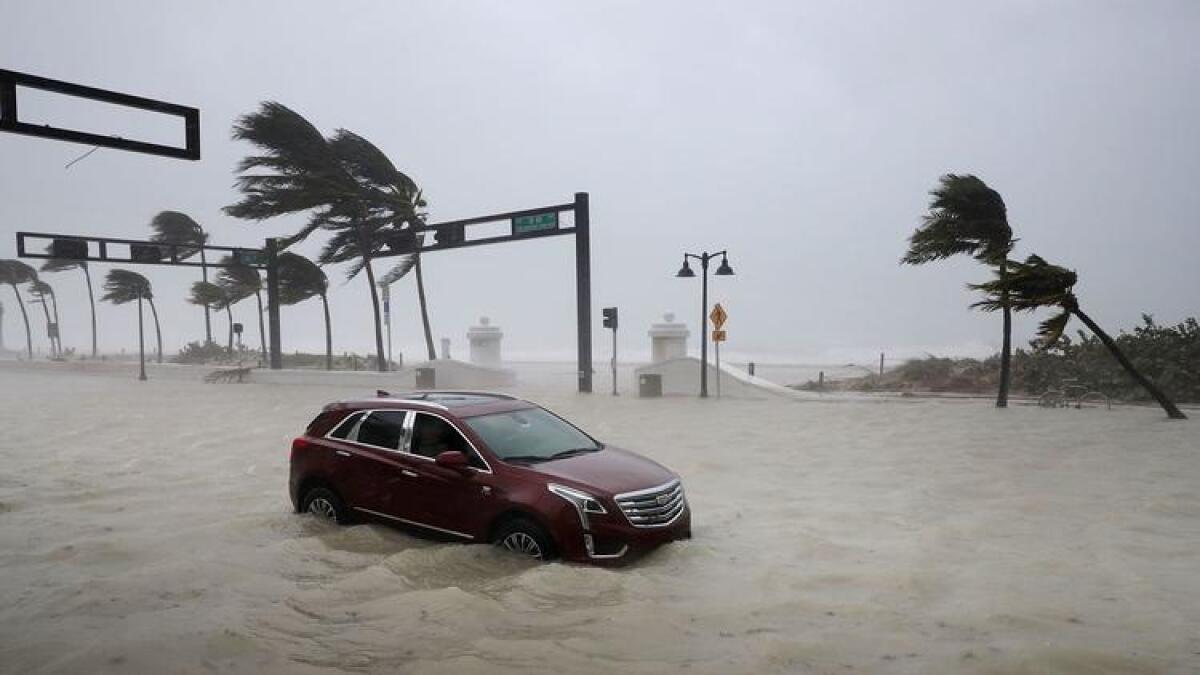
Hurricanes are often defined and categorized by their wind speed, but the real danger comes not from furious winds but from the sudden, often fatal rise of the sea.
There is more loss of life through drowning than any other of the various deadly hazards posed by these tropical storms.
Here’s how it happens.
- Share via
Irma spawning tornados in Central Florida
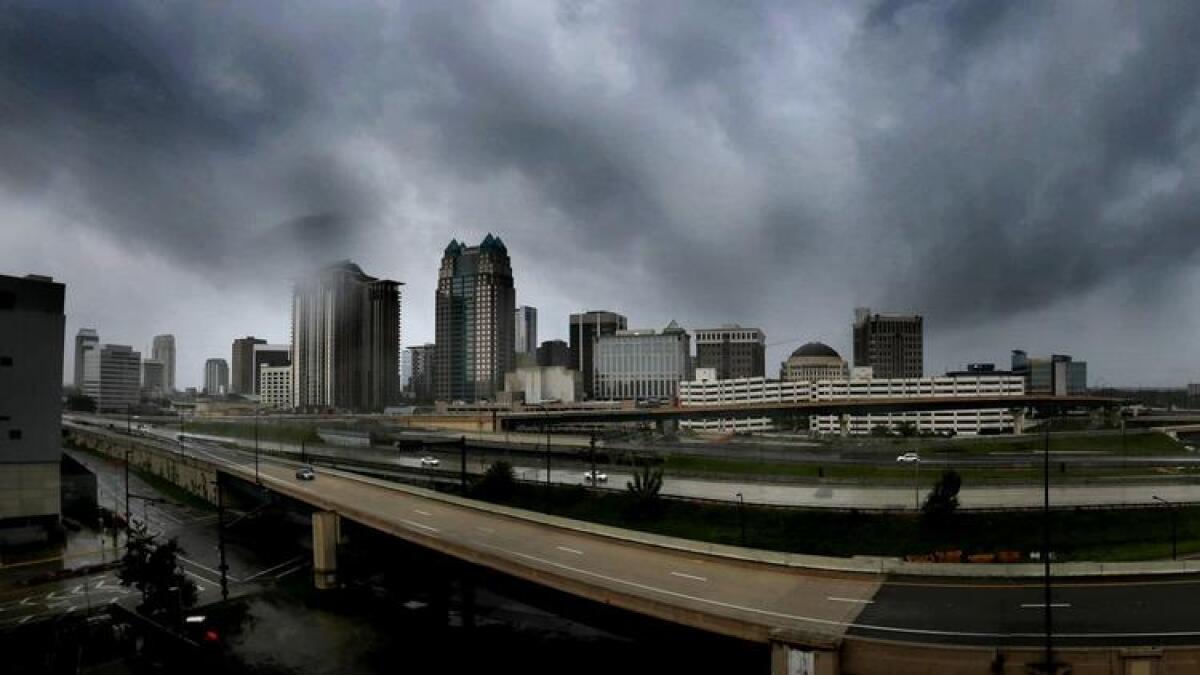
Central Florida is being spared the harshest winds of Hurricane Irma. The greatest danger here may be from tornados that are spawned over the Atlantic and develop over land.
Four concurrent tornado warnings have been issued for parts of Brevard, Seminole, Volusia and Orange counties. Tornado sirens were going off in various parts of the area.
The University of Central Florida issued a warning for its main campus: “Seek shelter immediately in the nearest building, away from doors and windows.”
The school also extended its closure through Wednesday.
A tornado warning is issued only after a tornado has been spotted.
Six homes in a trailer park in Palm Bay Estates were damaged by a tornado, mostly roofs being torn off. There were no reports of injuries.
Hurricane-fueled tornados are generally smaller and less intense those that crop up under different conditions. The winds are usually less than 100 mph.
The heavy rains started about 2 p.m. for the areas surrounding Orlando.
Winds were topping 40 mph by late afternoon with the highest winds of 70 to 80 mph expected by 3 a.m. or 4 a.m.
Seminole, Orange and Osceola counties have imposed 7 p.m. curfews scheduled to last until Monday night.
- Share via
‘At least it’s safer than the house’: Tales from the storm front in Miami

In downtown Miami, the few hotels open also served as paying shelters for many fleeing Hurricane Irma.
“It’s fine. At least it’s safer than the house,” said Chris McShane, who was staying at a Homewood Suites in the Brickell neighborhood.
He was here with his wife, Jennifer McShane, and two children, Ashley, 1, and Riley, 2. They were found in the hotel restaurant, the kids’ games spread along a table. The couple decided to leave their home in North Miami as Irma closed in.
Outside, glass windows displayed a glowering panorama: sheets of rain and a ferocious wind that felled trees and sent debris flying about, with some gusts reported in excess of 100 mph. The downtown towers nearby loomed below a gray sky. The sound of the wind was a constant backdrop for conversations among guests in the more than 100 rooms, all booked since Friday.
Still, all expressed relief that the storm had veered west and had not hit Miami head on. There was a palpable sense of catastrophe averted, even as the storm blew at gale force outside.
The mood was laid back. Someone stroked a guitar. Various dogs, the pets of patrons, occasionally ran about. On occasion, guests would step downstairs to the garage to catch a glimpse of nature’s fury, but most soon retreated. A pair of television news crews would do occasional stand-ups from the garage entrance.
The hotel had limited power after a transformer blew out early Sunday, but the McShanes, like some others, were using car batteries to charge computers. They planned to watch the U.S. Open tennis final in the afternoon and possibly catch a football game in the evening.
Behind the hotel front desk, German Castro was feeding bits of apple to his family’s 9-year-old vegetarian pug, Annie, who rested serenely on a blanket.
“She gets scared a bit with the lightning and thunder, but she feels safe here,” said Castro, a union organizer who took shelter with his wife, Angelica Castro.
Castro said he had experienced hurricanes before at his home in Florida, and preferred to be in the hotel. The past storms “felt like a truck running over the house,” he explained.
Also at the hotel was a sizable contingent from the government of the village of Key Biscayne. Situated on a barrier island that initially had been expected to receive a direct hit from Irma, the town was under an evacuation order. Fire, police and other officials had set up a command center at the hotel.
“We’re all itching to get out there and help, but safety comes first,” said Eric Lang, Key Biscayne fire chief.
As the afternoon wore on, the winds outside seemed to be diminishing. But from inside, it was hard to judge.
- Share via
Here’s what Irma’s going to do when it moves north out of Florida
- Share via
Hurricane Irma: What you need to know
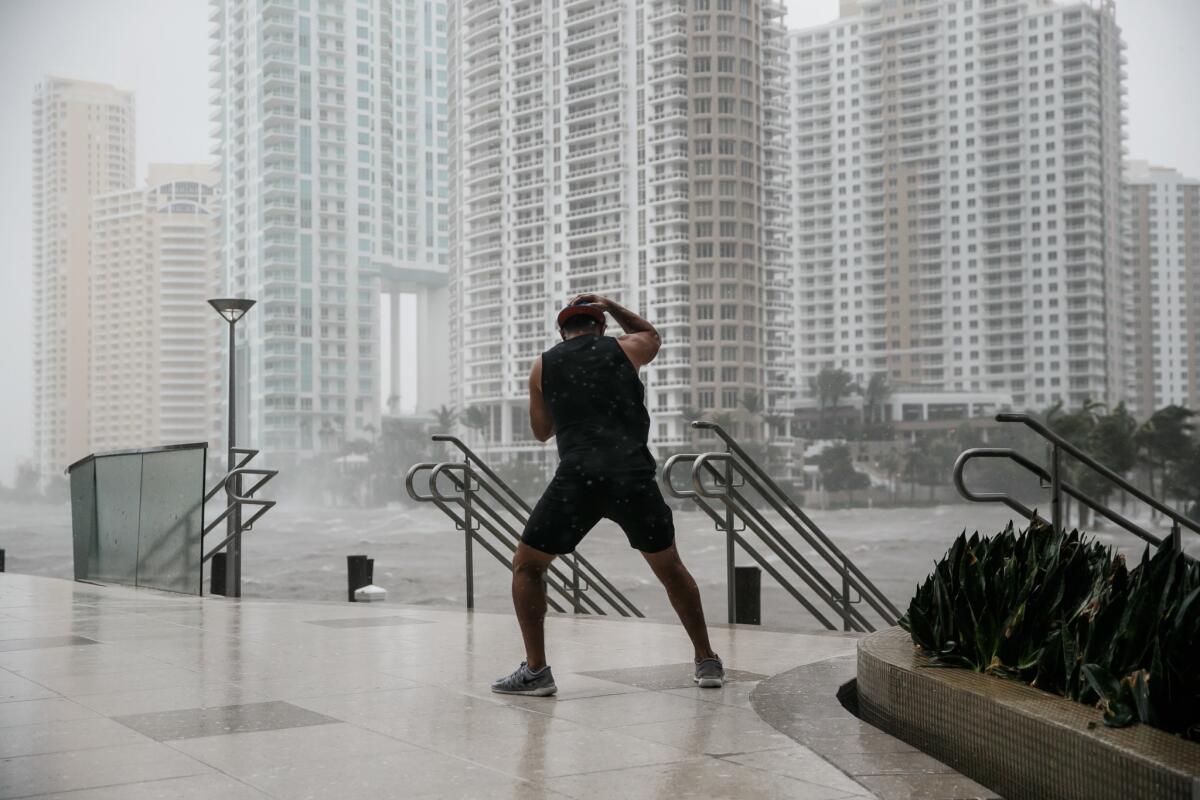
After blazing a path of destruction through the Caribbean, Hurricane Irma made landfall in Florida on Sunday, bringing chaos as it moved north through the nation’s third-most populous state.
Are you wondering where Irma is now, how big it is, and where it’s headed next? We have all you need to know.
- Share via
President Trump approves disaster declaration for Florida as Irma strikes

President Trump approved a disaster declaration for Florida on Sunday, clearing the way for more support as Hurricane Irma slammed the state with powerful winds and storm surges.
The declaration authorizes the use of federal funds for the counties of Charlotte, Collier, Hillsborough, Lee, Manatee, Miami-Dade, Monroe, Pinellas and Sarasota.
“Assistance can include grants for temporary housing and home repairs, low-cost loans to cover uninsured property losses and other programs to help individuals and business owners recover from the effects of the disaster,” the Federal Emergency Management Agency said in a news release.
Florida Gov. Rick Scott requested the declaration earlier Sunday.
“I have spoken with the president nearly every day, as well as today, and as well as our other federal partners,” Scott said at a news conference. “We are working very closely with the federal government to make sure Floridians have the resources they need for this storm.”
- Share via
Irma downgraded to a Category 2 storm as it makes its way across southwest Florida
Hurricane Irma weakened to a Category 2 storm Sunday as it made its way across land, up the coast of southwest Florida.
The storm made its second landfall at Marco Island, near Naples, bearing blinding rains and sustained winds of 115 mph, gusting to 130 mph. Later, the National Hurricane Center reported that sustained winds had ebbed to 110 mph as the eye of the storm passed over Naples.
Still, the storm was likely to maintain hurricane strength at least through Monday, despite “significant weakening” over land, the center said.
“There is imminent danger of life-threatening storm surge flooding along much of the Florida west coast,” with rising sea levels of 10 to 15 feet, it said.
Weather forecasters said heavy rain and inland flooding was occurring across much of Florida, and would likely spread quickly to the rest of the southeast United States as rainfall of 2 to 4 inches per hour brings flash flooding and rapid rises in creeks, streams and rivers.
- Share via
Water levels already beginning to rise near Naples, National Hurricane Center warns
- Share via
Flooding in downtown Miami
- Share via
From the waterfront in Fort Myers not long before Hurricane Irma arrived
Reporter Evan Halper and photographer Carolyn Cole took a rainy tour of the waterfront in Fort Myers, Fla., just hours before Hurricane Irma made landfall just south, at Marco Island.
Later, they documented the rising winds and pummeling rains as the storm drew nearer.
- Share via
Irma’s second landfall is at Marco Island, south of Naples
Hurricane Irma made a second ferocious landfall near Naples on Sunday after inundating the low-lying Florida Keys, sending floodwaters surging into downtown Miami and menacing millions in Florida’s Gulf Coast cities where some had initially sought shelter from the storm.
As the fierce Category 3 storm tracked its way up Florida’s west coast, water was sucked from part of Tampa Bay, exposing a muddy expanse that would normally be underwater — a frightening portent of flooding to come when that water, and more, comes rushing back.
The cities bracketing the bay — Tampa and St. Petersburg, with a population of some 3 million people between them — were forecast to be clobbered later Sunday by sustained hurricane-force winds.
“We are about to get punched in the face by this storm,” declared Tampa Mayor Bob Buckhorn.
- Share via
St. Petersburg, Fla., prepares for the possibility of a direct hit
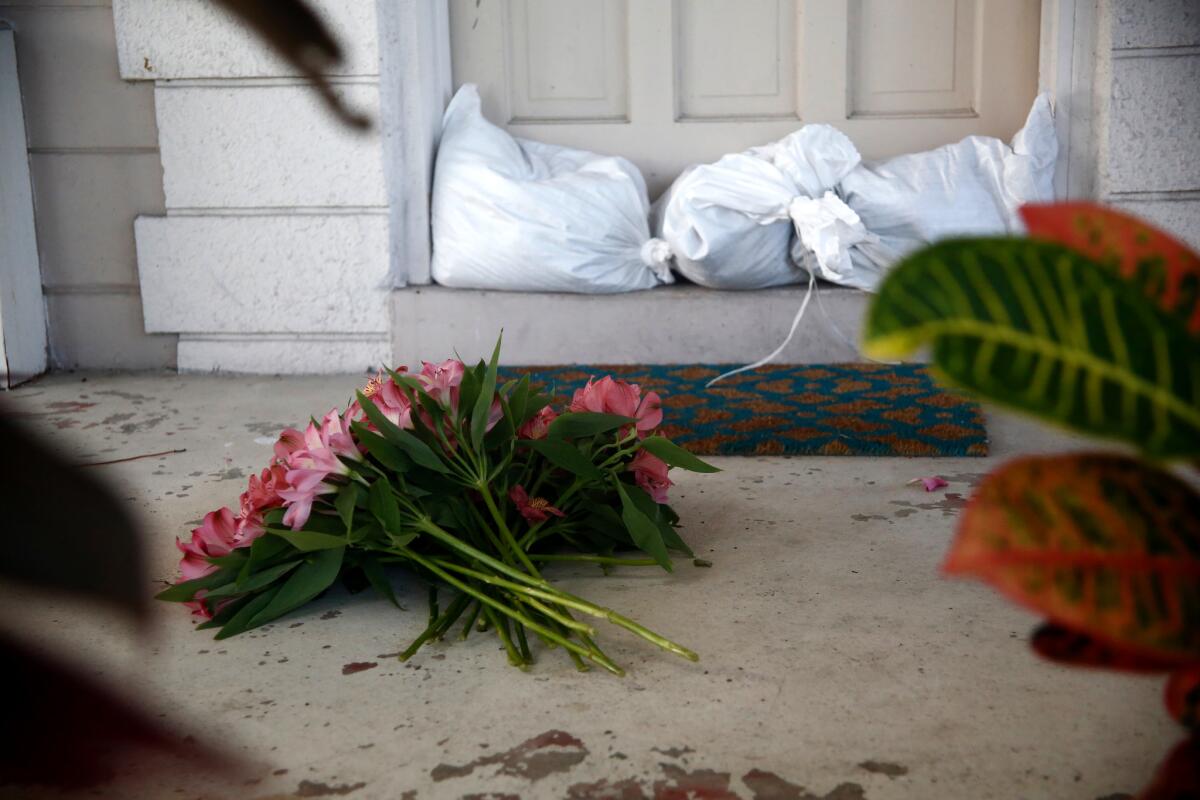
In St. Petersburg, Fla., poised to take a possible direct hit from Hurricane Irma, officials were bracing for the onslaught expected late Sunday.
The St. Petersburg police chief announced in a statement that a curfew would begin at 5 p.m., and Mayor Rick Kriseman warned that first responders would not be able to respond to emergency calls once winds reach more than 40 mph. Those services would “return when conditions are safe,” Kriseman told the Los Angeles Times by phone. “All residents need to be off the roads and taking shelter.”
Pinellas County Sheriff Bob Gualtieri’s staff was busy relocating 1,000 inmates from the county jail.
Between St. Petersburg and Clearwater, which make up two-thirds of the Tampa Bay metro area, roughly one million people live in neighborhoods that are close to waterways and are especially susceptible to flooding.
Sheriff’s deputies were already blocking access to the barrier islands that make up part of the county’s living areas.
In addition, Gualtieri was restricting access into all entry points of Pinellas County until a damage assessment and safety inspection could be carried out, according to a statement just after 1 p.m. Sunday.
- Share via
Another collapsed crane is dangling above Miami buildings and streets
- Share via
Stations keep football on TV despite the hurricane

If you live in Florida, the only thing you watch more than the weather is football. And for one brief weekend, the weather took precedence. But not everywhere.
People in South Florida had more to worry about than any football game. But if you were not in the direct path, in a place such as Orlando, what would a local television station do balancing a big local news story and an audience that wants its football?
Some residents just wanted a break from the constant drumbeat of hurricane coverage, especially when the storm was still hours away.
The opportunity to watch the local college teams on Saturday was no factor as Florida, Florida State, Miami, Central Florida and South Florida all cancelled their games, even if they were out of town.
The ABC, CBS and NBC affiliates in Central Florida went to 24-hour storm coverage early Saturday morning. The Fox affiliate chose to air football Saturday afternoon and night. So, if you wanted to watch the national broadcast of USC beating Stanford, you could watch it just like any other Saturday night.
NBC affiliate WESH-2 moved the Notre Dame-Georgia game on Saturday to its sister station WKCF-18, interrupting its duplicated hurricane coverage. The anchors announced the change with regularity.
Sunday belongs to the NFL, but even with the Tampa Bay at Miami game being moved to later in the season, there were still out-of-market games.
Fox affiliate WOLF-35 went to around-the-clock coverage on Sunday and moved the Atlanta Falcons-Chicago Bears and Seattle Seahawks-Green Bay Packers games to its sister station WRBW-65.
All that was left was what the CBS affiliate WKMG-6 would do with the Jacksonville Jaguars at Houston Texans game. There was no sister station so it sent the game to its subchannel 6.2 and then brokered deals with cable carriers Spectrum, Cox, Comcast and others to send the game to a vacant channel.
If you had DirecTV, it didn’t really matter, as service was intermittent when bands of heavy rain and cloud cover interrupted the signal in central Florida.
Taking football away from an invested television market isn’t as easy as it sounds, no matter how big the story.
- Share via
Braving the gusts in downtown Miami
- Share via
Hurricane Irma heads north with 130-mph winds
A 92-mph wind gust was reported at Miami International Airport Sunday as Hurricane Irma slammed into South Florida. At 1 p.m. Eastern Time, the Category 4 storm was 50 miles south of Naples, according to the National Hurricane Center.
The latest forecast puts Naples, Tampa and the western coast of the Florida peninsula directly in the path of the storm, which is generating sustained winds of 130 mph.
The storm is expected to plow into the Tampa Bay area by early Monday morning.
- Share via
Two law-enforcement officials die after head-on crash during Irma’s approach
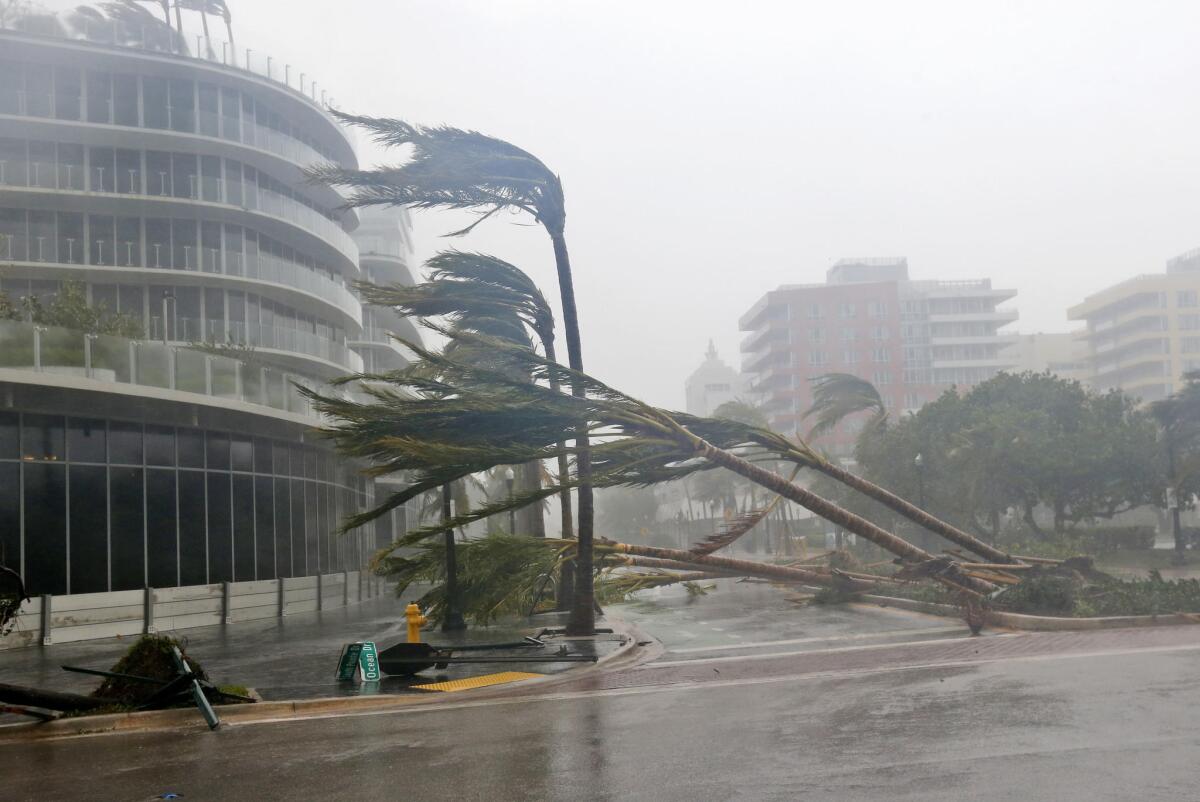
Two law-enforcement officials died after their vehicles crashed head-on in a rural county southeast of Tampa, Fla., Sunday morning as Hurricane Irma bore down on the state, according to the Florida Highway Patrol.
The drivers were Hardee County Sheriff’s Deputy Julie Ann Bridges, 42, of Wauchula, Fla., who was headed home in her marked sheriff’s cruiser, and Hardee County Correctional Institute Sgt. Joseph J. Ossman, 53, of Sebring, Fla., who was on his way to work in a 2012 Nissan Altima.
Local media reported that Bridges had just ended her shift at a hurricane shelter.
A state police crash report indicated that officials were still trying to figure out why the crash happened and whether the approaching storm was a factor. Both were wearing their seatbelts. Their agencies did not immediately respond to requests for comment.
“Our thoughts and prayers are with the Hardee County Sheriff’s Department, the Florida Department of Corrections and their families!” Florida Highway Patrol Lt. Gregory S. Bueno said in a statement.
News of the fatal crash came as more Florida law-enforcement agencies, citing safety, began pulling their officers and deputies off the roads as Irma began pummeling more of the state Sunday morning.
State officials are also investigating a nonfatal officer-involved shooting that happened during a burglary at 2:53 a.m. in the city of Weston, a suburb of Fort Lauderdale in the southeast corner of the state, as the area was battened down for the storm’s approach.
“Out-of-town homeowners alerted Broward Sheriff’s Office deputies around 3 a.m. Sept. 10 that their home surveillance system had captured burglars inside their home,” the sheriff’s department said in a statement.
Officials said two juvenile burglars were involved. At least one deputy shot at a juvenile suspect and hit him, according to the statement, which did not give further information about the age of the suspect, the nature of his nonfatal injuries, whether he was armed, and why he was shot.
He was taken to the hospital, and his alleged partner was taken into custody, though officials did not say what charges he might face.
A spokeswoman for the Broward County Sheriff’s Office referred questions to the Florida Department of Law Enforcement, which did not immediately respond to a request for comment.
- Share via
109-mph gust recorded in Broward County as Hurricane Irma heads toward Gulf Coast
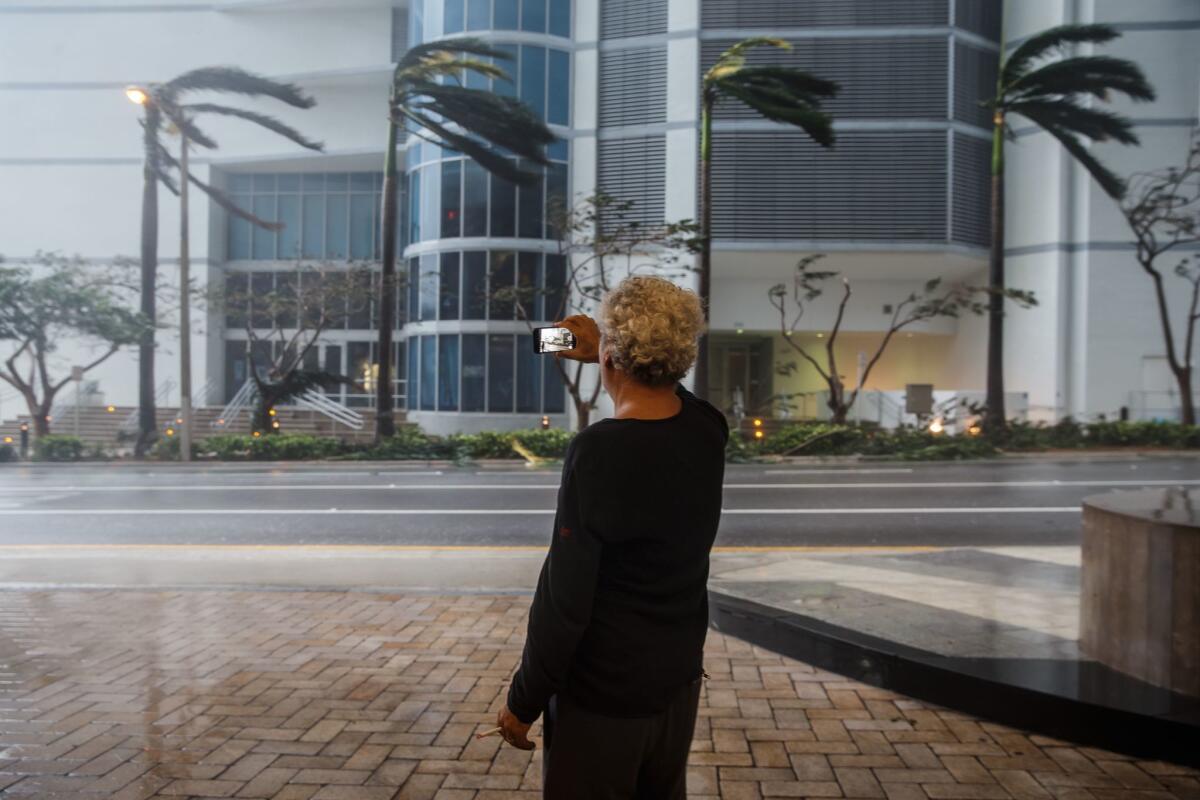
A 109-mph gust of wind hit north of Miami, a crane collapsed in downtown Miami and a powerful storm surge sent ocean water flooding into Miami’s Brickell Avenue Sunday, as the hazards of Hurricane Irma started striking at full force in South Florida.
The gust was detected at a middle school in Pembroke Pines, in Broward County, the National Hurricane Center said in a report issued at noon Sunday. The storm turned Brickell Avenue into a river, with waist-deep water flowing up the road. The crane collapsed at 300 Biscayne Blvd., prompting the city of Miami to issue a statement urging residents to stay away from windows facing the collapsed crane.
The hurricane retained its 130-mph strength late Sunday morning as its eye crossed the Florida Keys and headed toward the Gulf Coast, where Naples, Fort Myers and Tampa rushed preparations for the Category 4 storm’s arrival.
- Share via
Scenes from a failed Miami Beach vacation

At a rain-lashed hotel in Miami, Leonardo Mureocca and his wife, Marcella, both 44, sat with their daughters, 12 and 8, in the main dining room on the second floor.
The family from Argentina had spent more than a week in Orlando visiting Disney World. They came to Miami Beach for the rest of their vacation, but then came Hurricane Irma.
“We tried to get a flight back to Buenos Aires, but our airline in Argentina stopped, so, you see we are here,” Leonardo Mureocca said. “It’s not what we planned. This is our first hurricane. We don’t have this kind of thing.”
Just outside the hotel dining hall was the pool, separated only by glass doors. The wind whistled through the cracks in the doorways as trees whipped back and forth from the wind.
The Mureoccas’ daughters sat glued to their cellphones, with the network still up at noon.
Across from the Mureoccas sat Alejandro Abascal, 52, and his wife, Camila, 43, both from Spain.
“We got here last Tuesday and were trying to get north on Thursday, but cars — rental cars — [were] not available,” Alejandro Abascal said. “So now we are here — just like them, not a hurricane before. Next time we’ll think about coming here at this time [of the year].
- Share via
Hurricane Irma clobbers Cuba, brings flooding to Havana
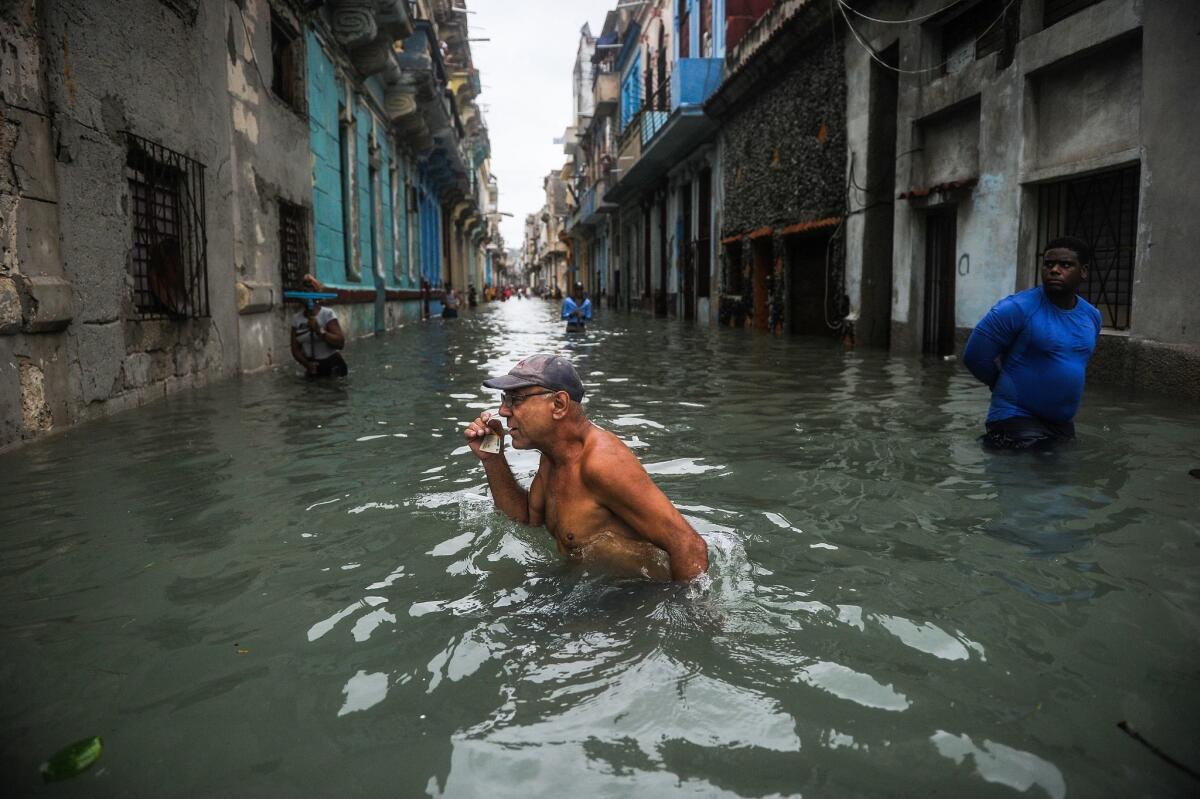
Hurricane Irma ripped roofs off houses, collapsed buildings and flooded hundreds of miles of coastline as it raked Cuba after cutting a trail of destruction across the Caribbean. It has killed at least 22 people and has officials scrambling to bring aid on Sunday.
As Irma left Cuba and directed its 130-mph winds toward Florida, authorities on the island were warning of staggering damage to keys along the northern coast studded with all-inclusive resorts and cities, as well as farmland in central Cuba.
There were no immediate reports of deaths in Cuba — a country that prides itself on its disaster preparedness — but authorities were trying to restore power and clear roads, and they warned people to stay off the streets of Havana because flooding could continue into Monday.
Residents of “the capital should know that the flooding is going to last more than 36 hours, in other words, it is going to persist,” Civil Defense Col. Luis Angel Macareno said late Saturday, adding that the waters had reached about 2,000 feet into parts of Havana.
As Irma rolled in, Cuban soldiers went through coastal towns to force residents to evacuate, taking people to shelters at government buildings and schools — and even caves.
- Share via
Why not go to a hurricane shelter? Two reasons: the boat and the dog

Michael Gandy, a 6-year Florida resident, has sheltered in a parking structure. “I’ve got run, cheese, tortillas and a lot of water,” he said.
After all the urgent warnings, the casing of neighborhoods by police insisting people leave, and the weather forecast that shows life-threatening conditions are certain, the holdouts who stay in evacuation zones are often motivated by one of two things, or both.
Boats and pets. Many Floridians don’t want to separate from them and worry, perhaps too much, about what will happen if they try to move them.
Michael Gandy is a boat guy. The 77-year-old was camped out in the parking complex of an apartment building in Fort Myers, right across the street from one of the more dangerous locations in Florida right now. That is where his boat is docked. Gandy lives on that boat. And he refuses to abandon it as a dangerous sea surge looms, which could lift the boat right onto the street.
The sunburned septuagenarian sporting a Hawaiian shirt with a wide-open collar, thick white beard and chain necklace was keeping his cool, even as the situation outside got increasingly scary. Asked if he has what he needs to ride it all out in an exposed parking lot, he insisted he did.
“I got rum, cheese, tortillas,” said Gandy. “I got it.” Then came a short chuckle with the truth. “Bottled water. That’s about it,” he said.
Gandy was not the only boat owner putting himself directly in harm’s way on the southwest coast of Florida. He had lots of company.
In the parking garage of the apartment complex, there were other vessel owners riding it out. The building managers of the unifinished complex are allowing owners of boats in the marina across the street to shelter in the garage. At least it is safer than being on their boats.
- Share via
Miami airport is closed, and the scene around it isn’t pretty
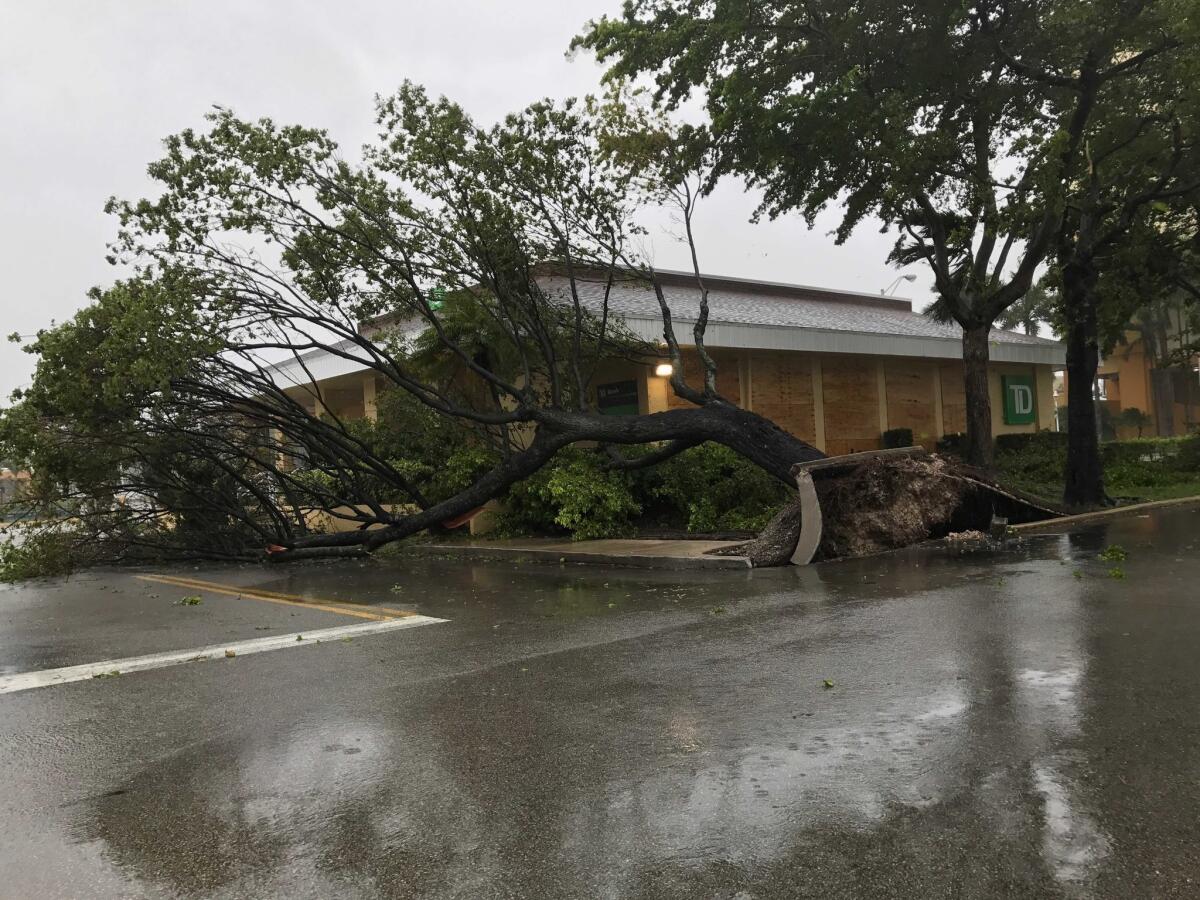
Miami International Airport is closed as Hurricane Irma’s heavy winds rage throughout the area.
Fallen trees, branches, light poles and other debris littered the roads near the airport close to Coral Gables.
No cars or police could be seen on the roads. Guests at the Hampton Inn & Suites were on edge as the electricity flicked on and off at about 11:25 a.m.
Elevators at the hotel were shut down by staff to avoid anyone being trapped in them, though the hotel does have a generator.
- Share via
In Fort Myers as Hurricane Irma approaches
- Share via
Waiting for Irma: ‘I’m afraid I won’t have a house to go back to’
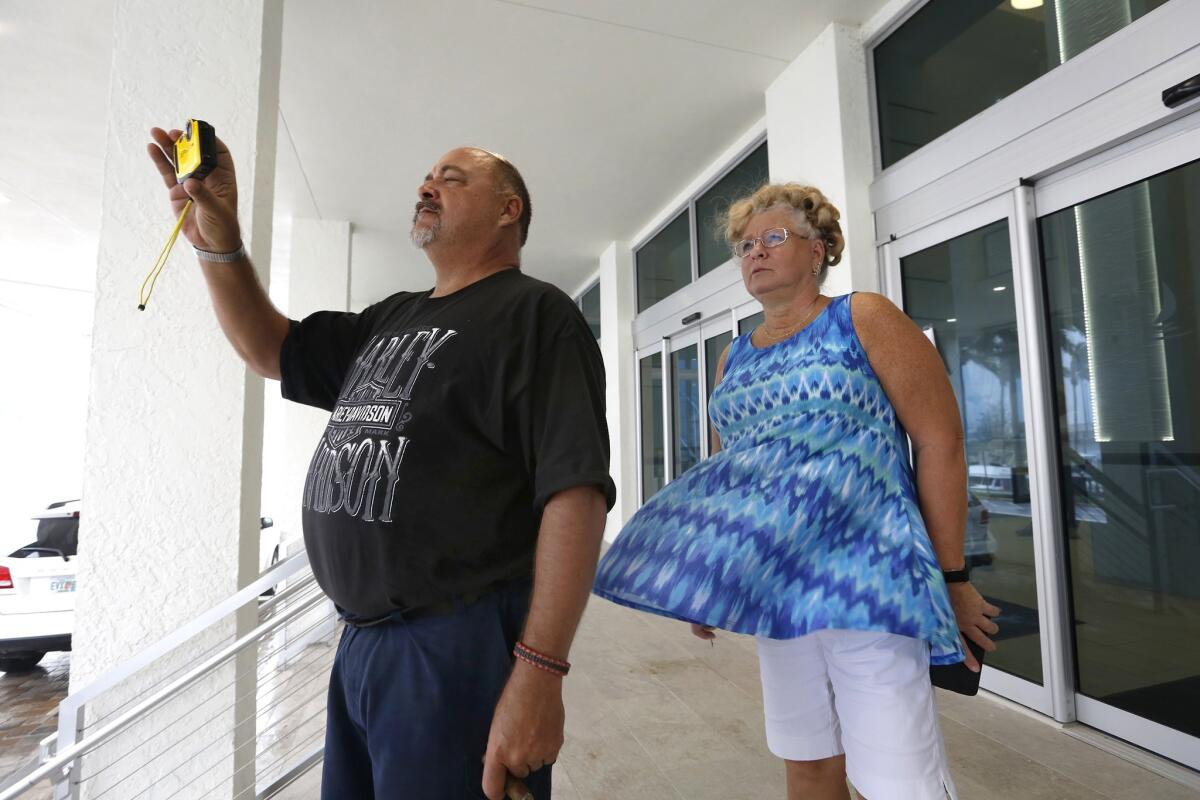
Diana Frana had two big worries as she rode out the storm right by the water in Fort Myers, Fla.: her own home, and the building where she was taking refuge.
“I’m worried I won’t have a house to go back to,” Frana said Sunday from the lobby of the Campo Felice apartment complex, where she and husband Ken McNeal work and were offered an apartment during Irma. They had fled a home on a canal in Cape Coral. They have two boats on it. The prognosis for any of it being there after all this is over is bleak.
But before the couple can get back to see what’s there, they have to make it through the hurricane. And Frana and McNeal were riding it out at a pretty hairy location. The building is sturdy, but also right across the street from the water. A big surge on the south side of the storm could have them stuck there for some time.
“My husband thinks if it comes up 12 feet it will be in here,” she said. That’s not much higher than forecasters are projecting. Frana was prepared to wait it out in the third-floor apartment they are in. If they get stranded up there for awhile, she said, so be it. At least they would be someplace dry.
Outside, the ferocity of the storm intensified as McNeal smoked a large cigar out on the front steps and shot photos on his phone of palm trees bending in the punishing winds and the boats across the street rocking in the choppy waters.
It was only the beginning of the storm and already it was hard to even stand on the sidewalk without getting blown back. The streets were deserted save for the staff of the Campo Felice and a few reporters getting knocked around by the wind.
- Share via
Almost impossible to stand upright in Miami
The wind is intensifying Sunday morning in downtown Miami to the point that it is impossible to stand upright.
Rain is pelting the street in waves, branches are breaking from trees and flying in the air.
One good thing: The wind is so intense that it’s immediately clearing rain from the streets and propelling it onto sidewalks and into drains -- its howl so strong that it’s almost impossible to hear anything else.
The force of the wind seems to be coming from all directions.
The outlines of people hunkered down in hotels or apartments can be seen staring through shuttered windows, in some instances filming with their mobile phones.
It seems to be getting darker out as the storm picks up pace. Streets are of course abandoned. Police and stranded civilians have gathered inside dimly lit lobbies of the few hotels open.
- Share via
Fort Myers is along the track of Hurricane Irma. Here’s what it looks like right now
- Share via
Homeless and nowhere to go in southwest Florida as Irma closes in
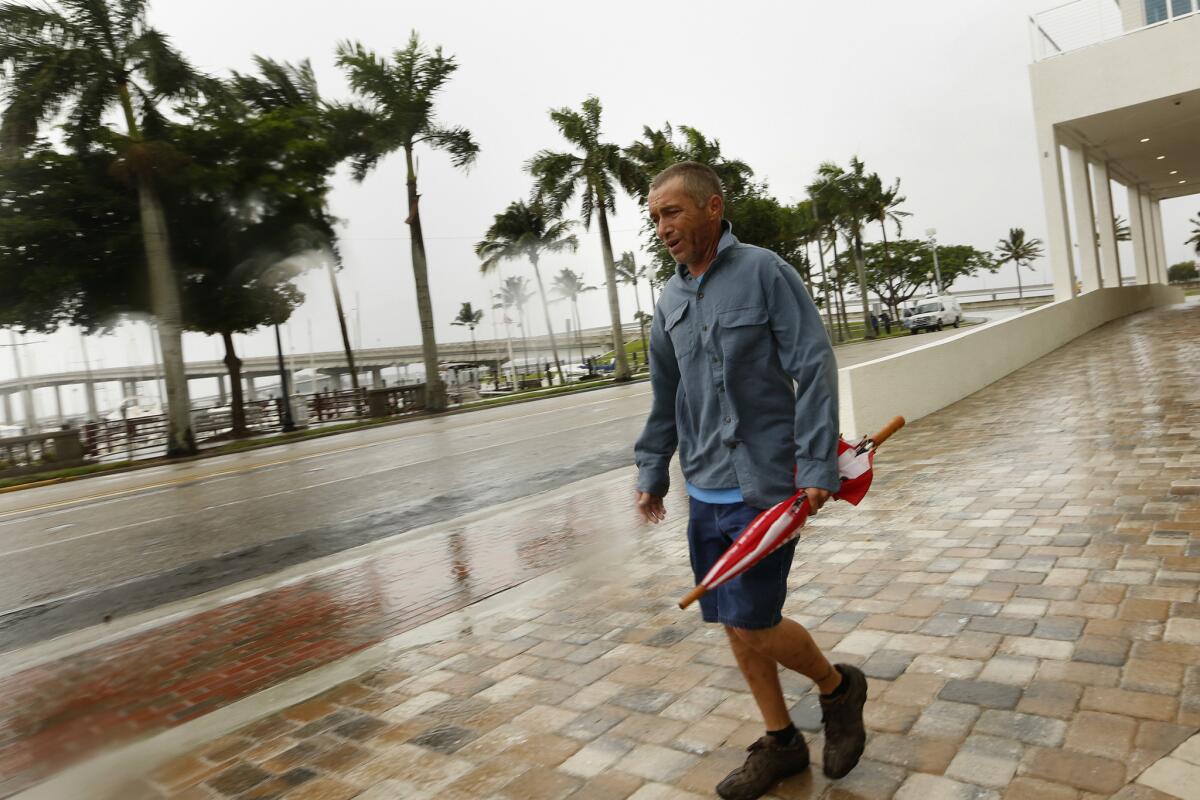
Brian Williams found himself caught in the rapidly intensifying storm in downtown Fort Myers early Sunday morning.
Williams has no home, and it was too late to make his way to a shelter. He had been staying with a friend in a mobile home. They thought they could ride out the storm there. Then they realized, as the storm came in, that they had better get out.
His friend and his friend’s family decamped to the home of someone else they knew. Williams, 41, had no place to go. He eventually found his way to the parking structure behind the Campo Felice building.
With nothing to protect him from the wind but an umbrella, Williams looked deeply anxious.
“I’m scared to death,” he said.
“I was trying to get to a friend’s house,” Williams said. His plan was to walk. “It got too bad,” he said.
This was Williams’ first hurricane. It was a frightening introduction.
“I’ve never been through a hurricane or anything like it,” he said, adding: “I don’t know anything about these storms. But I know this is bad.”
- Share via
Florida already seeing blinding rain and high winds as Hurricane Irma marches through the Keys
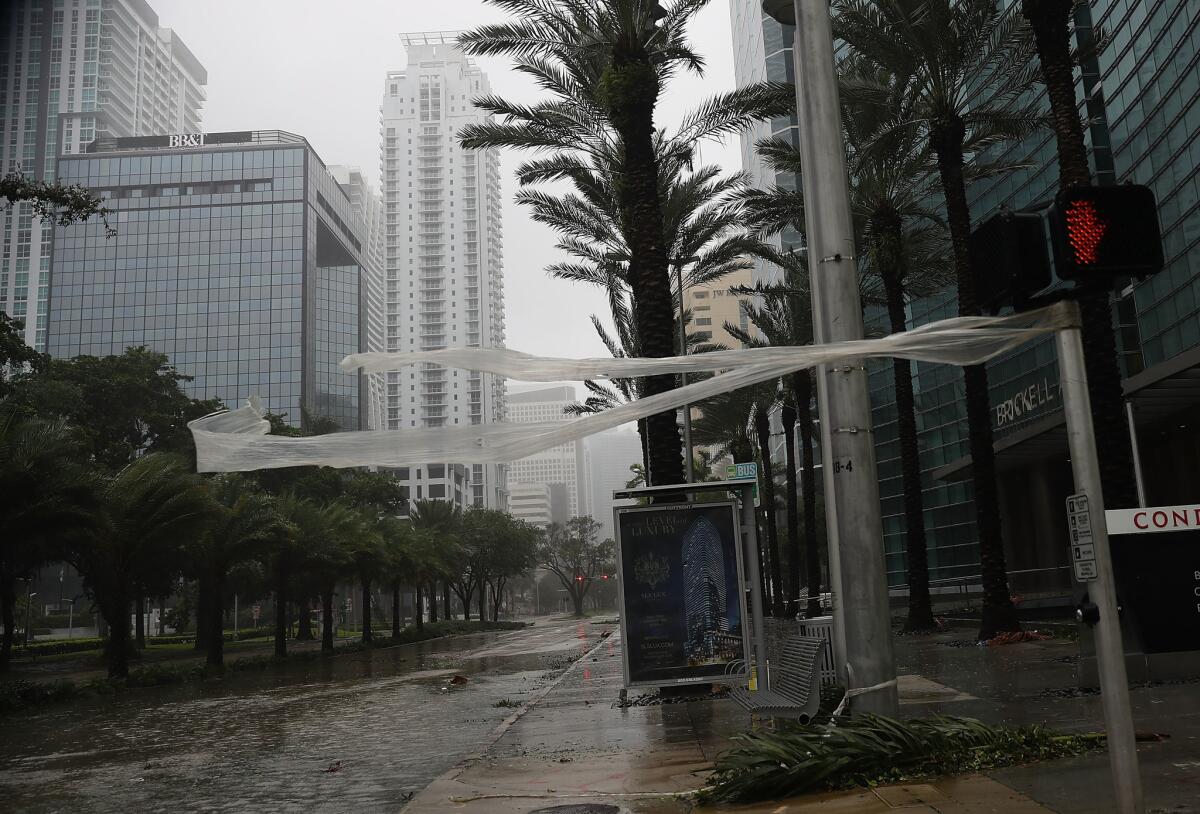
Hurricane Irma made landfall in the Florida Keys Sunday morning, inundating the storied low-lying islands and propelling a vanguard of blinding rains, shrieking winds and precipitous floods over a far larger swath of Florida.
“Pray for us,” Gov. Rick Scott said before dawn as Irma’s eyewall began moving over the lower Keys. Just after 9 a.m., it made landfall on Cudjoe Key with top sustained winds of 130 mph, the National Hurricane Center in Miami said.
With the Category 4 storm on a havoc-filled trajectory up Florida’s Gulf Coast, much of the state was a jumbled tableau of overflowing shelters, boarded-up buildings and deserted streets in normally bustling urban centers. Palm trees blew sideways or snapped off under the assault; tree branches flew like missiles; an estimated 800,000 were without power.
- Share via
Miami may have escaped a direct hit from Irma, but it’s already pretty intense there
Almost horizontal sheets of rain were whipping Sunday morning throughout downtown Miami, where branches and downed trees lined the streets and sidewalks.
There were no cars moving on the roads. Police and other law enforcement vehicles were remaining off the streets except in emergencies.
Water was pooling, and winds were picking up and expected to intensify. The sound of the wind reverberated through the streets. Power was spotty with widespread outages. Authorities warned people to stay off the streets.
Already, there were substantial power outages.
- Share via
Florida Gov. Rick Scott: ‘The biggest thing right now is pray for us’
- Share via
Hurricane Irma’s eyewall reaches the Florida Keys
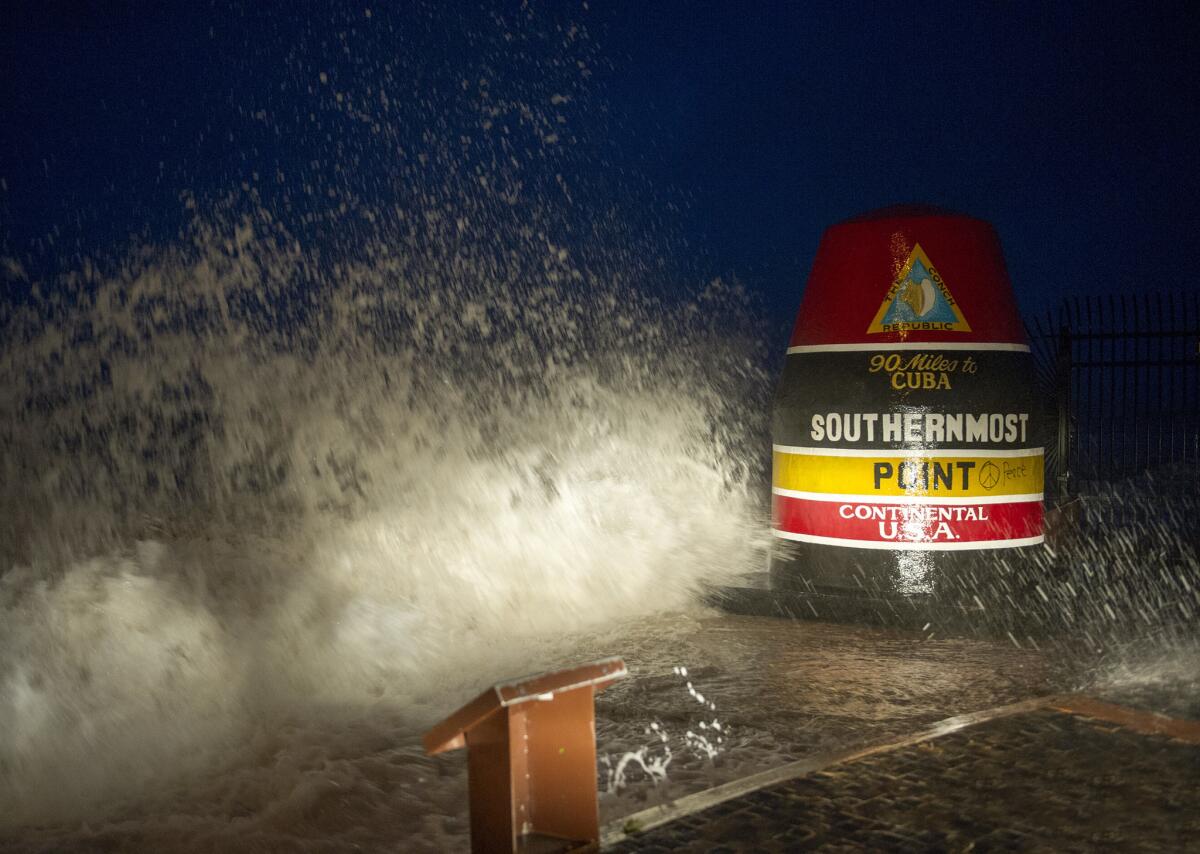
The U.S. National Hurricane Center in Miami says the storm’s northern eyewall reached the lower Florida Keys on Sunday morning. The eyewall is a band of clouds surrounding the center of the storm that has intense winds and strong rain.
The hurricane center says Key West International Airport has measured sustained winds of 50 mph.
Hundreds of thousands of people were without power in Key West and in places including Miami that were being hit with strong winds and rain.
Florida Power & Light Co. said about 430,000 customers were without power Sunday morning. Miami-Dade County had the most outages with about 250,000. Broward County had 130,000 outages. Palm Beach County had more than 40,000 outages.
The utility said it has mobilized crews and is working to restore power as it can.
- Share via
National Weather Service issues extreme wind warning for the lower Keys
The National Weather Service issued an extreme wind warning for the lower Florida Keys in Monroe County on Sunday morning, until 9:15 a.m. Eastern Time as it was approached by the eyewall of Hurricane Irma — the ring of tall thunderstorms that produce heavy rains and usually the strongest winds.
The National Weather Service warned anyone in the area to move to interior rooms away from windows.
- Share via
Hurricane Irma’s landfall is expected to break historical records
As Hurricane Irma nears Key West, it’s expected to break several historical records — including the first time the U.S. has been struck by two Category 4 hurricanes in the same year, following Hurricane Harvey in Texas, the Weather Channel reports.
Only six Category 4 or stronger hurricanes have tracked within 75 miles of Key West in the historical record, per Jonathan Erdman, a meteorologist with the Weather Channel.
- Share via
Irma’s eye is about to move across the lower Keys, National Hurricane Center says
Hurricane Irma has sped up slightly, and its eye is about to move across the lower Florida Keys, the National Hurricane Center said early Sunday.
The hurricane is centered about 40 miles south-southeast of Key West and is moving north-northwest near 8 mph.
Irma is a Category 4 hurricane with maximum sustained winds near 130 mph. The National Hurricane Center said that Irma is forecast to weaken but will remain a powerful hurricane as it moves through the Florida Keys and nears Florida’s west coast.
- Share via
National Weather Service warns Florida Keys: ‘TIME TO HUNKER DOWN’
The National Weather Service issued an urgent warning early Sunday as Hurricane Irma bore down on the area.
The storm was expected to make landfall in Florida within hours, Gov. Rick Scott said.
The worst of the storm was expected to hit the lower Keys between 7 and 8 a.m., local time.
- Share via
Storm surge reported in Key West, tornado warning issued for Fort Lauderdale area
A re-strengthened Hurricane Irma is continuing to move toward the western Florida Keys.
The hurricane regained Category 4 status late Saturday with maximum sustained winds near 130 mph. It was centered about 55 miles southeast of Key West as of 4 a.m. local time on Sunday.
The National Hurricane Center said the Miami Executive Airport had measured a sustained wind speed of 46 mph with a gust of up to 61 mph.
A storm surge had begun to affect Key West by about 4 a.m., with the National Weather Service reporting the water level had risen 2 feet above normal.
Further north, a tornado warning was issued for a swath of cities along Florida’s coast, the weather service said. That was in effect until 4:15 a.m. Sunday.
Tens of thousands in Florida were huddled in shelters as the hurricane threatened to make a catastrophic hit on the state within hours.
- Share via
Sustained hurricane-force winds expected to reach Keys in 1 to 2 hours
- Share via
Hurricane Irma strengthens back into a Category 4 storm
Hurricane Irma has strengthened back into a Category 4 storm as it approaches the lower Florida Keys, according to the National Hurricane Center.
The National Hurricane Center said that sustained winds had reached up to 130 mph as of 2 a.m. Eastern time. The storm was about 70 miles away from the Keys and moving at 6 mph.
Irma was expected to reach the Keys around daybreak Sunday.
- Share via
Hurricane Irma’s path continues to shift west — and that could put St. Petersburg in its track
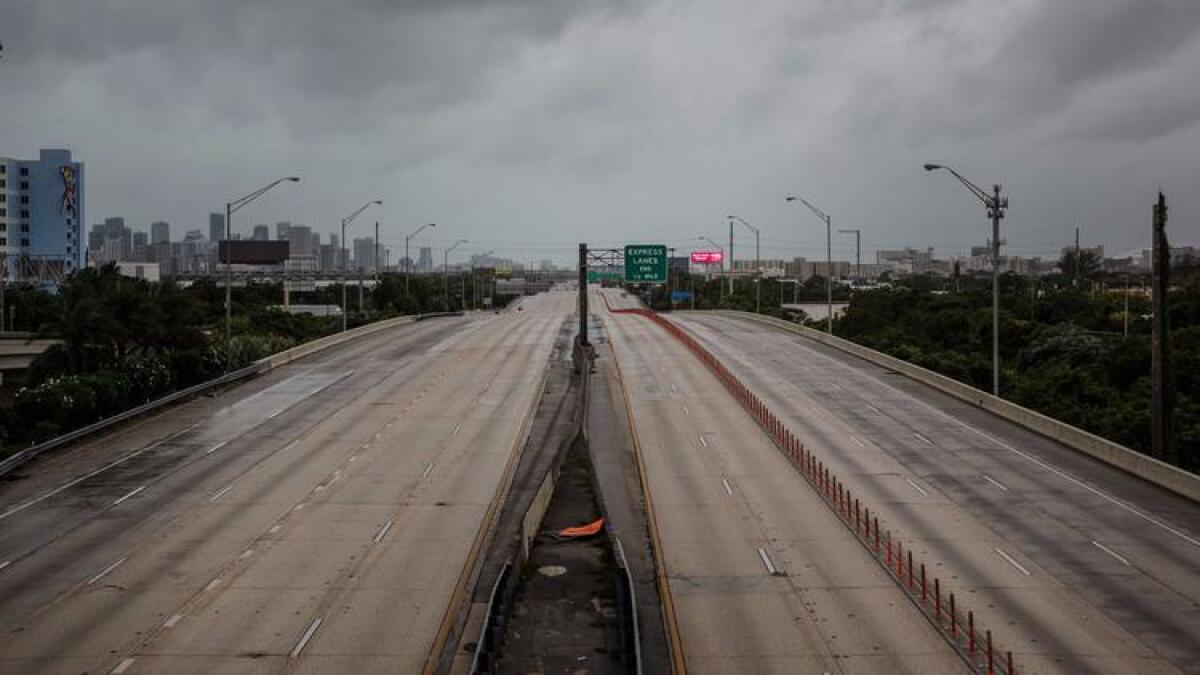
The National Hurricane Center says Irma’s projected path is continuing to shift to the west, just a few crucial miles, that should keep its eye just off Florida’s west coast on a track to hit St. Petersburg, not Miami or even Tampa.
The hurricane’s leading edge was already lashing the Florida Keys with hurricane force winds. If the center of the storm keeps moving over warm Gulf of Mexico water, it may regain more strength before making landfall again.
St. Petersburg, like Tampa, has not taken a head-on blow from a major hurricane in nearly a century. Clearwater would be next, and then the storm would finally go inland northwest of Ocala.
The storm currently has top sustained winds of 120 mph (193 kph) and is moving northward at about 6 mph (10 kph).
- Share via
Emergency operations centers are up through the night monitoring Irma’s progress
- Share via
NOAA’s prediction was right. It’s been a busy hurricane season
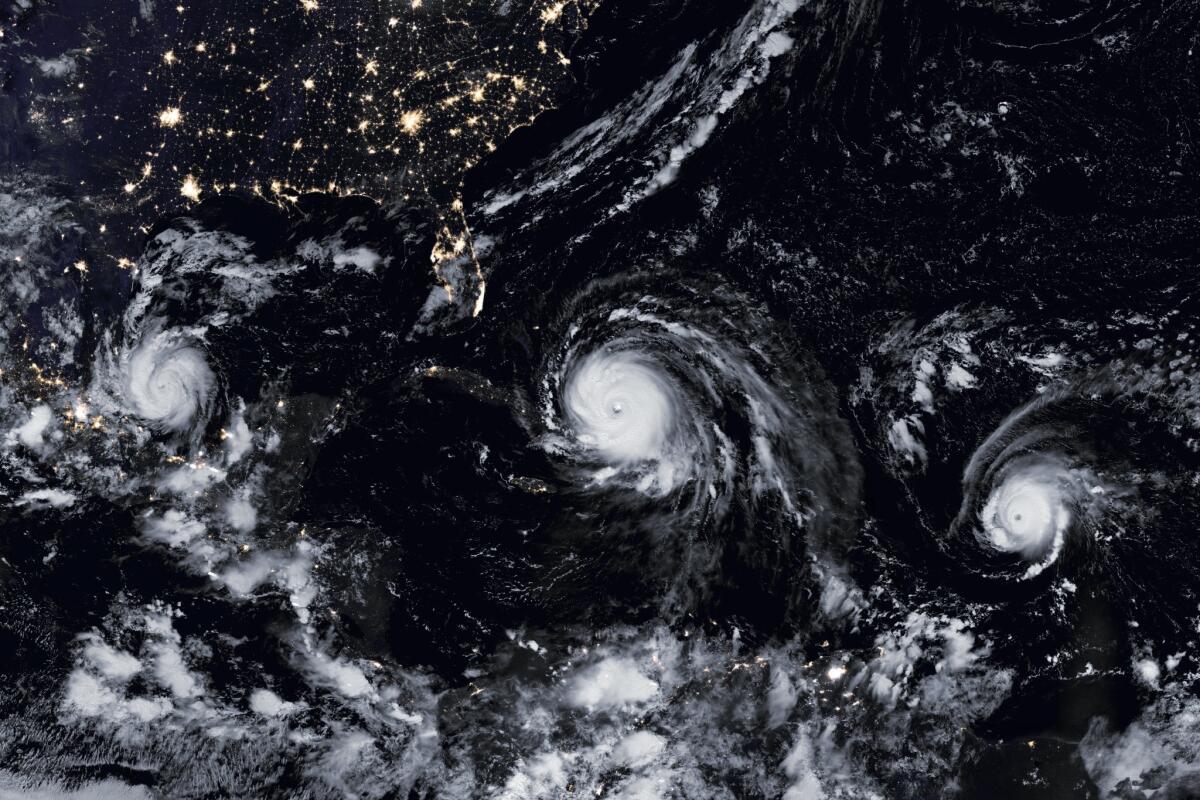
Those forecasters at NOAA were right. Back in May, they predicted an above-normal 2017 Atlantic hurricane season – with two to four storms Category 3 or stronger.
Well, so far we’ve had three hurricanes that exceed that standard – Harvey, Irma and Jose.
The season got off to an unusually early start in April with Tropical Storm Arlene. The Atlantic Hurricane season officially runs from June 1 to Nov. 30.
Four more tropical storms followed: Bret, Cindy, Don and Emily. But then came August, and with it, a string of hurricanes, starting with Franklin, which made landfall in Mexico as a Category 1 storm. Hurricane Gert blew in next. The first Category 2 storm of the season, it drifted out over the Atlantic.
The rest of the season is painfully familiar. Hurricane Harvey slammed into Texas as a Category 4 storm. Hurricane Irma at one point achieved Category 5 status as it has been churning towards Florida. Right behind is Jose, a Category 4. (And did we mention Hurricane Katia?)
The National Oceanic and Atmospheric Administration based its forecast on the a number of factors, including above-normal ocean surface temperatures.
Category 3 storms pack winds of at least 111 mph. If NOAA’s prediction holds, we’re due for yet one more big hurricane before the season is over.
- Share via
‘This is the way a storm comes’: Hemingway’s angry take on the most powerful hurricane in U.S. history
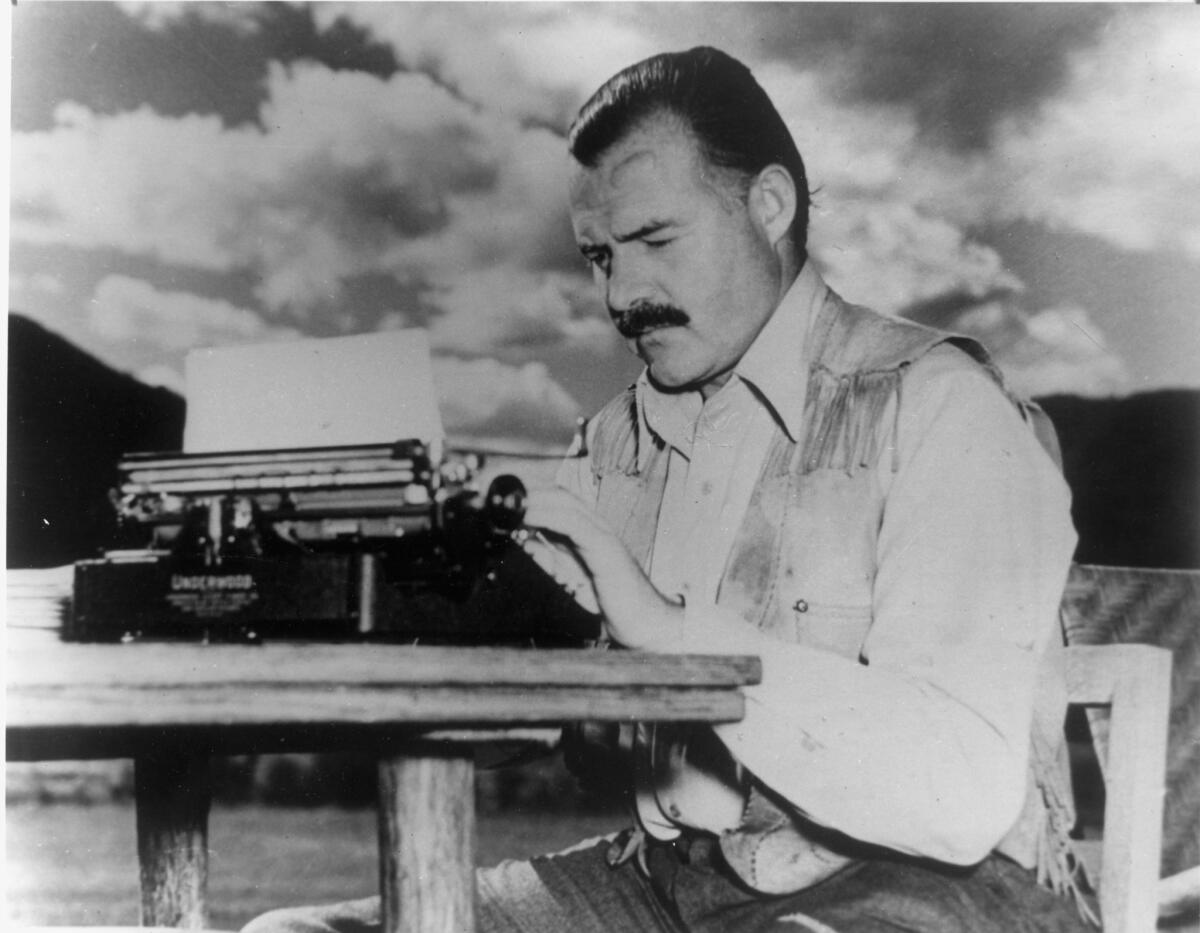
The Category 5 Labor Day Hurricane of 1935 is the strongest storm ever to make landfall in the United States.
It killed at least 485 people, including at least 257 military veterans who had been deployed to the Florida Keys to construct the bridge linking the string of islands.
Two weeks later, the leftist journal The New Masses published a two-page essay, “Who Murdered the Vets? A First-Hand Report on the Florida Hurricane,” by Ernest Hemingway describing the storm and condemning Washington for failing to evacuate the veterans.
“This is the way a storm comes,” he wrote. “On Saturday evening at Key West, having finished working, you go out to the porch to have a drink and read the evening paper. The first thing you see in the paper is a storm warning.”
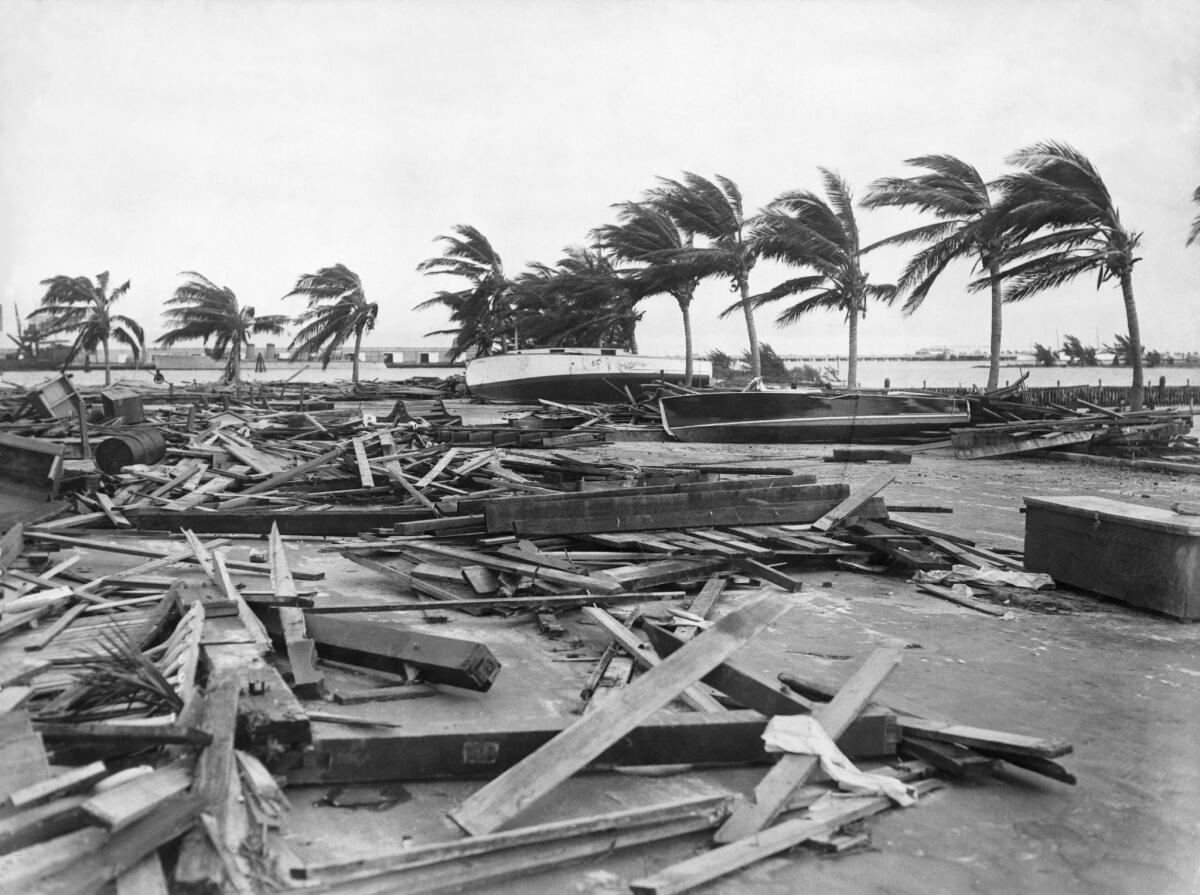
- Share via
Irma remains a ‘major hurricane’ threatening ‘all of South Florida,’ weather service says
- Share via
First hurricane-force winds have hit the Florida Keys
The Florida Keys began to feel the wrath of Hurricane Irma Saturday night as the powerful storm headed on a collision course with the western coast of Florida, which braced for a potentially devastating day of deadly winds and surging seas.
Irma was expected to unleash its full fury of 125 mph winds sometime around sunrise over Key West, barring a sudden change in direction, with the Fort Myers-Naples area in the storm’s relentless cross hairs by midafternoon.
Hurricane-force gusts were already blasting the spindly islands of the Keys on Saturday night, while escalating winds, driving rain and isolated tornadoes surged across Florida on the massive storm’s leading edge.
- Share via
A view of Irma’s damage from the U.S. Virgin Islands
- Share via
President Trump as Irma approaches: ‘God bless everyone!’
As Hurricane Irma barreled closer to the Florida coast on Saturday night, President Trump sought to reassure those in the path of the storm.
- Share via
A look at the Caribbean islands hit by Hurricane Irma
As the strongest hurricane on record headed toward South Florida, it first had to get past several small Caribbean nations.
The Franco-Dutch island of St. Martin suffered significant damaged when Irma slammed into it Wednesday. Up to 70% of the houses on the Dutch side of St. Martin were badly damaged or destroyed, Dutch officials reported Saturday. The French government said that 95% of the French half of St. Martin had been destroyed.
Irma inflicted similar damage on the island of Barbuda. Prime Minister Gaston Browne initially estimated that 95% of the properties on the island had been damaged or destroyed — then later said the losses were probably even worse. About 1,600 Barbuda residents were evacuated to Antigua.
Here is a briefing on some of the island nations hit by Irma.
- Share via
Preparing for Irma? There’s an app for that
Zello, an app that turns cellphones into walkie-talkies, connecting and broadcasting traffic like a police scanner, has become an emergency hub for nervous Floridians awaiting Hurricane Irma’s landfall Sunday.
The technology originated a decade ago, and was increasingly used during clashes in Egypt, Ukraine and Venezuela. Last week, it became the most popular free app for both Android and iPhone users after Hurricane Harvey struck Texas. Volunteers there used Zello channels such as Cajun Navy Dispatch to provide advice to flood victims and information to civilian rescuers.
Late Saturday, one of the most popular channels, Hurricane Irma, had attracted more than a thousand users from across the world, primarily in Florida.
Calls came from young mothers, teenage boys, power line workers, veterans and emergency responders. Some reported tornadoes, others rising water, exploding transformers and suspicious activity on web cams. Some worried about looting. They shared storm surge maps, apps to track tornadoes and monitor weather radar. Many asked about evacuating. A few joked. Most pleaded for help, worried that time was running out for them and their families.
A glimpse of their fraught discussions, starting just after dark at 7 p.m. Eastern time (some users rely on nicknames, while others provide their real name and location):
Barbaraw2 (New Middletown, Ohio): People in the Sarasota area evacuate now. You have exactly one hour. If you do not know where a shelter is, look up www.capecoralupdate shelter. There are shelters open now.
CaraRogers (Palm Bay, Fla.): Guys to correct her, you have 45 minutes, not an hour. Barbara can you copy, 45 minutes?
Barbaraw2: Copy Cara, I meant to say 45
Pusom (Nelson Gonzalez): Is there any way I can get wifi during the storm?
CaraRogers: At this time guys, Wifi is the least of your worries
Ameer Saleem 18: Xfinity has set up mobile hotspots throughout Florida.
Kdrkvz: (Dave, assistant emergency coordinator, Galloway, NJ) There was a woman asking about Spanish language info, can you let her talk?
Pacposhopez: (boy chuckling) Um, I got a question, what’s the name of the hurricane?
Lcjcus: Someone should be talking about the tornado warnings in Palm Beach and Miami Dade counties that were just issued
Rosa&Lex (Rosa, shelter worker, Las Vegas): Hey guys, I just want to let you know that I have a channel for the Spanish speaking community it’s ##irmaayudainformacionespanol
CommsTech: There’s also sister site of ours that’s Hurricane Irma espanol.
Dylan_ball: People who haven’t evacuated already are frickin ignorant. This is ridiculous.
Red Actual (Delray Beach, Fla.): You need to evacuate. The storm has shifted to western Florida. Storm surges are expected to rise to 12 feet. The governor has issued an evacuation. If you do not evacuate you will not get rescued until the storm passes.
Kearrah Hollis (Floral City, Fla.): If you are in need of rescue put a bright colored towel or sheet on top of your house.
PJS203: Por favor hablo espanol, gracias.
Pierre G (Ontario, Canada): Multiple tornadoes have touched down in Broward County as we speak
Benbruh (youth): There’s a tornado in Tampa. Please leave the area now
Beaver (youth): I’m in Tampa, there’s no damn tornado.
CaraRogers: Guys, we have to keep these channels clear! This is some people’s only way to get assistance, because 911 is not going to be dispatching fire and police. You will be silenced if you come in with something irrelevant. Keep the station clear.
Iamnisa1: Does anybody know when the hurricane is coming to Lehigh Acres, Ft Myers area? I have a one year old and I’m really worried. I’m not prepared.
CaraRogers: To the mother of the one year old, you still have time to get to call 311 and get to shelter.
Sammy9225 (Samantha Allen, Port Richey, Fla.): Is it too soon to have a bag ready to go? I have two bags ready for me and my family and should I take my son’s car seat out of my car now or leave it in there?
Rubenthecuben1 Ruben Solis, Summerfield, Fla.): I live in a mobile home, do you have any idea what I should do? Board up my windows?
CaraRogers: If you are in a mobile home you need to evacuate immediately and get to a shelter.
Rubenthecuben1: So should I not board up my windows or should I board up my windows on my mobile home?
Barbaraw2: No, you should get out of your mobile home now!
(people laugh) No seriously, you can board up your windows if you want, but I would not stay there in that mobile home. You really seriously need to evacuate and go to a safer place.
Barbaraw2: Also if you evacuate, take a black sharpie and put the number of people that went with you so that keeps the rescuers from having to come up to check. It just keeps everything going.
Uomshouse: Don’t let people know you evacuated unless you want to get robbed.
Barbaraw2: Your personal stuff is not important as much as your life is.
Sammy9925: (baby cries in background) I’m in Port Richey, Florida. When it hits and if our windows break and we go to the middle of our house, what do we do after that because we did not get enough wood to do all of our windows, unfortunately.
CaraRogers: What you are going to do is go to a center area with no windows or if it gets to be as serious as it may you’re going to want to go into the bathroom and get your family into the bathtub and cover the bathtub with something that can shield you from falling debris.
Stormwatch3000: If you get in a bath tub for a tornado the best thing to put on top of you is a mattress.
Joako537: I’m here in Tampa trying to find out where I can get a generator.
CommsTech: Man, I think you’re a little late on that.
- Share via
Silence before the storm at Miami International Airport
- Share via
Key West already being buffeted by Hurricane Irma’s leading edge
South Florida was starting to feel the effects of Hurricane Irma, with the National Weather Service reporting that the area is starting to see hurricane-force wind gusts with some tornadoes possible.
Meteorologists expect tropical storm-force winds to reach Central Florida starting about 2 p.m. Sunday and increase to 60 to 80 mph throughout the day.
Hurricane warnings expanded to include Orange, Lake, Seminole and Volusia counties Saturday morning. Orange, Seminole and Osceola are now along the eastern edge of forecasters’ cone for the eye’s possible path. The mandatory evacuation of all mobile homes in Seminole and Orange counties were also issued today.
Seminole County instituted a curfew from 7 p.m. Sunday to 6 p.m. Monday.
“Our personnel are encouraging residents to leave their mobile homes and make their way to designated shelters,” said Orange County Mayor Teresa Jacobs. Hurricane Irma’s winds dropped to 120 mph, moving west-northwest at 7 mph after having moved west much of the day along the Cuban coastline.
- Share via
Hurricane Jose expected to weaken as it pulls away from islands in northern Caribbean
A chain of already battered islands in the Northern Caribbean avoided a direct hit from Hurricane Jose, a Category 4 storm with 145 mph winds, that is forecasted to move further northwest and weaken on Sunday.
The government of Antigua called off a tropical storm warning for the sister islands of Antigua and Barbuda. A tropical storm warning remains in effect for St. Martin and St. Barthelemy.
Swells generated by Jose will begin to hit Puerto Rico, Hispaniola, the Turks and Caicos Islands and portions of the Bahamas over the next few of days.
The National Weather Service said these swells are likely to produce “life-threatening surf and rip current conditions.”
The service said Jose will begin to gradually weaken Sunday and continue to simmer down Monday.
- Share via
Night falls, and a last-minute evacuee looks for shelter
- Share via
Potential for ‘the worst hurricane in history’ in southwest Florida
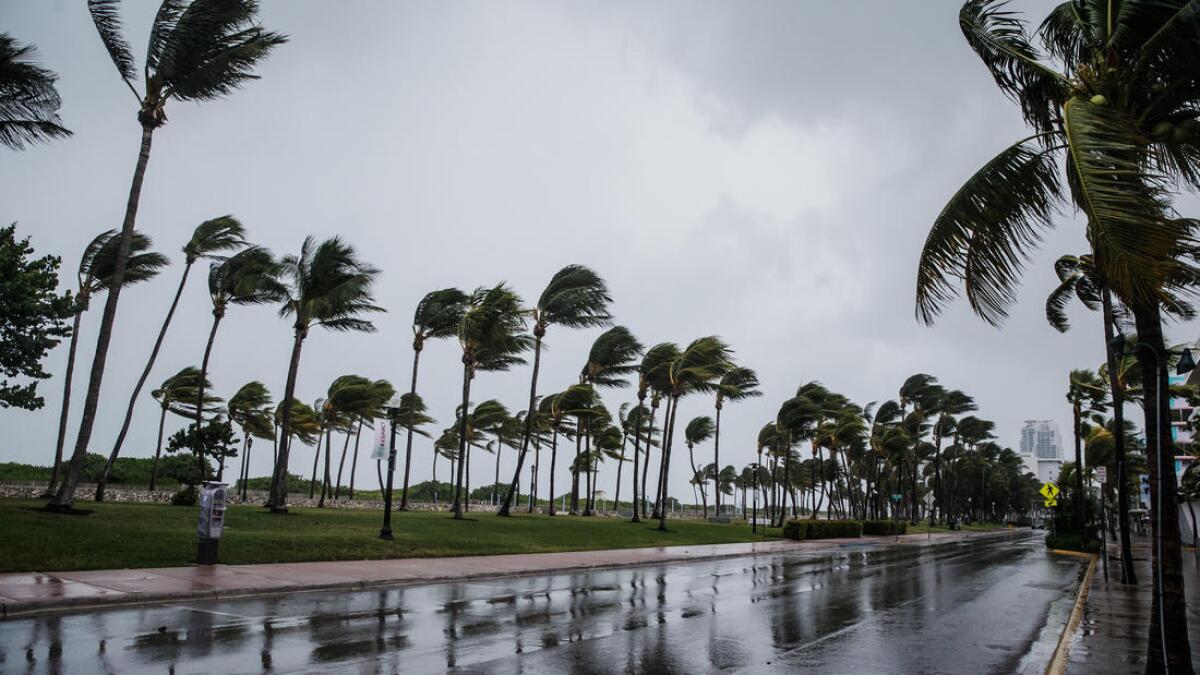
The Weather Channel’s hurricane specialist, Bryan Norcross, is not mincing words about Hurricane Irma’s expected impact on the west coast of Florida -- where forecasters say the storm will probably hit on Sunday.
In a Facebook post, Norcross warned that Irma’s expected storm surge could be devastating in an area not accustomed to such high water levels.
In SOUTHWEST FLORIDA – the NAPLES-FT. MYERS-CAPE CORAL area, the potential exists for the worst hurricane in history. The core of Hurricane Irma, potentially with winds gusting over 150 mph or more, is going to come close. Buildings in Southwest Florida are not, in general, built to withstand these winds. As the peak winds approach the Gulf water will surge over the islands and the shoreline of the mainland, so it will be very difficult or impossible to move once the storm starts.
Once the eye goes by, the maximum surge – forecast to be 8 to 12 feet above the ground in low-lying areas – will move in from the Gulf. This is fast moving, destructive water. You cannot drive through it and you cannot stand in it. It will sweep buildings away. Storm surge is the deadliest hazard in a hurricane.
The water will surge miles inland in some areas – far up the Caloosahatchee River, for example – higher than you can imagine. It is critical that everyone makes it to high ground.
Norcross wrote a book about Hurricane Andrew, the 1992 storm that swept across the Bahamas and Florida, causing $26.5 billion in damage and leaving 65 people dead.
- Share via
Hurricane Irma likely to strengthen back into a Category 4 storm before reaching Florida
Hurricane Irma will probably regain strength and become a Category 4 storm as it moves away from Cuba and enters the warm waters south of Florida.
Irma is likely to reach the lower Florida Keys around daybreak Sunday, the National Weather Service reported in its latest update.
Officials are urging people to wrap up their storm preparations and evacuate. The threat of flooding is the worst in southwestern Florida, where 10 to 15 feet of inundation is expected.
The storm is expected to dump between 10 to 20 inches of rain over most of the Florida Keys, the Florida peninsula and southeast Georgia. Some locations could see as much as 25 inches in all Saturday through Monday.
While Miami is still expected to get hurricane-force winds of up to 90 mph and a storm surge of 3 to 6 feet, weather forecasters said the area would probably not see the kind of devastation the region suffered with Hurricane Andrew in 1992.
The National Weather Service issued a tornado watch for the area around North Miami Beach at 8 p.m. local time.
Increasingly, it appears that southwestern Florida, the area around Fort Myers and Naples, is likely to bear the brunt of the storm — with Tampa and St. Petersburg also along the storm’s latest projected path.
Winds are already picking up: The National Weather Service in Key West reported 61-mph winds at its office.
The National Weather Service in Miami put out a video on social media Saturday urging people to evacuate from southwestern Florida.
“This is a life-threatening situation. If you have been ordered to evacuate and haven’t already done so, you are risking serious injury or even death,” said meteorologist Robert Molleda. “Please evacuate immediately. Save your life and those of your loved ones.”
- Share via
In Tampa, the last flight out before the storm
- Share via
Police removing homeless from the streets of Miami as Hurricane Irma approaches
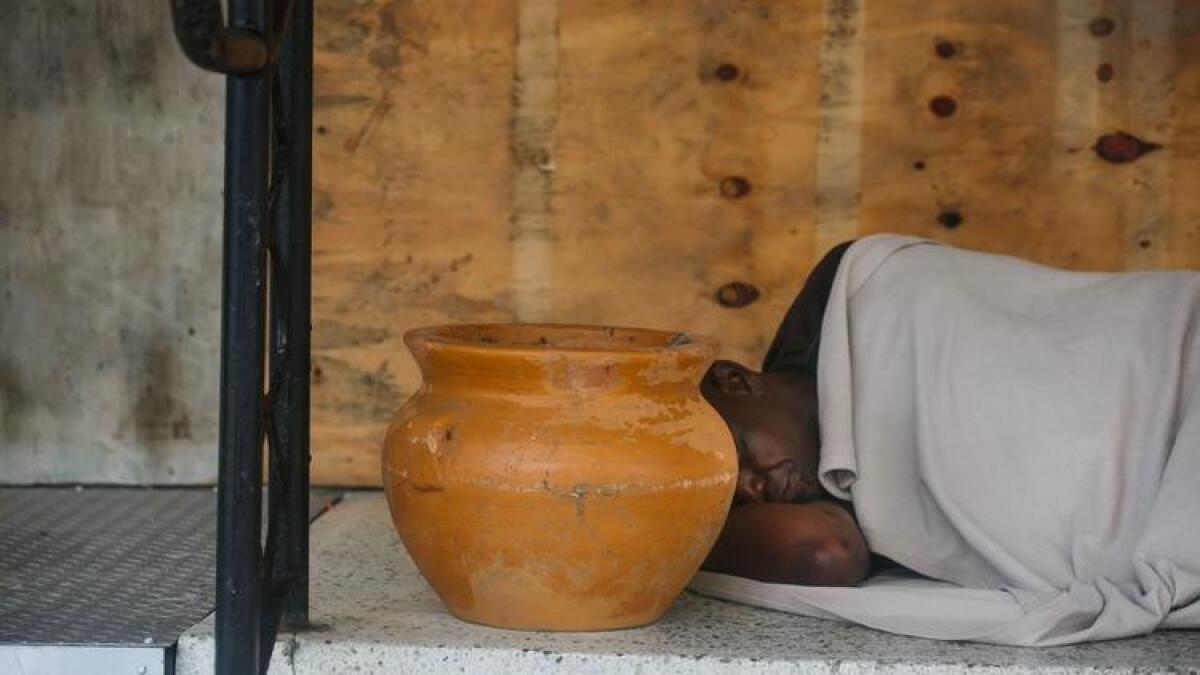
While Miami was mostly evacuated by Saturday, one group still had a noticeable presence: the homeless.
“I’ll be all right,” said Terry Donald, who estimated he had been living on the streets here for two years, as he shuffled barefoot down a deserted downtown street. “I think I’ll make it through.”
In the hours before Hurricane Irma was expected to pummel Florida, authorities were urging homeless people to go to shelters.
For those who refused, police were employing a controversial law known as the Baker Act, which allows officers to send anybody they believe poses a danger to themselves or others to a mental institution, where they can be held for up to 72 hours for an involuntary examination.
- Share via
Hey, a hurricane’s coming. Wanna go to the beach?
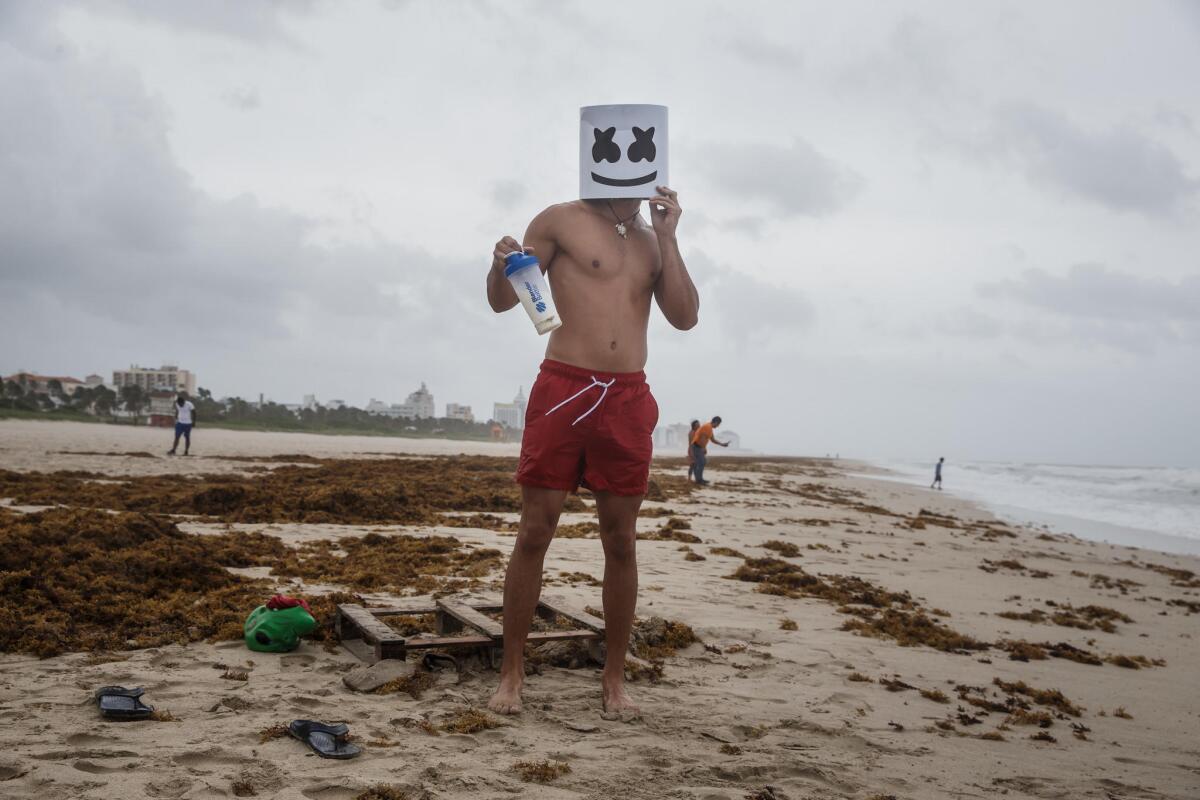
Despite the mass evacuation ordered in Miami Beach, Fla., there were offbeat moments Saturday as Hurricane Irma closed in and unleashed increasingly powerful winds and sheets of rain.
On the mostly deserted beachfront, some were using the impending tempest as a backdrop for filming humorous scenes that they planned to post on social media.
“I always wanted to come down the beach in a hurricane, but my parents never let me,” said Rafael Cabanzon, 20, who, along with a friend, Victor Herrera, also 20, was frolicking Saturday in the storm-whipped surf.
Cabanzon donned a combination mask-helmet with a stylized smiling face — a copy of the disguise worn by Marshmello, the DJ and dance music producer. Cabanzon stood in the surf in Marshmello look-alike guise while Herrera filmed him.
“I could be Marshmello,” he said, noting the mysterious identity of the masked DJ.
Farther up the beach, as wind-whipped sand struck the skin like high-powered pellets, Oscar Silva slipped on a mask of President Trump.
“There is no hurricane!” intoned Silva, in his Trump disguise, as his friend, Sandra Hernandez, filmed the mock interview amid blowing wind and rain. “It’s all fake news!”
- Share via
Near Fort Myers, a very long shelter line is filled with shell shock
It was a long slog to get into the Germaine Arena near Fort Myers on Saturday, where thousands of shell-shocked locals waited hours on end to claim a cot. Many of them never had expected to be at a shelter. They had taken precautions to avoid it.
But the evacuation zone kept growing and growing, ultimately encompassing many of the hotels where locals planned to take refuge. They had nowhere to go but the shelter. Inland areas that had been declared out of the way of serious harm only a day earlier suddenly became extremely hazardous to inhabit. People there, too, had nowhere to go but the shelter.
Many brought dogs. One family had three of them in tow, two poodles and a poodle-golden retriever mix. But Barbara Sobol, a 70-year-old who had never before been in a shelter, left her cat at home. The commotion at the shelter, she feared, would be more upsetting to her pet than the commotion of 140-mile per hour winds and torrential rain battering their house.
“They didn’t tell us we were being evacuated until the very last minute,” Sobol said. “I left food for her at high elevations in different places. She’ll find it…. This shelter is a strange, noisy place. She’d be scared here.”
- Share via
Florida allowing drivers on the shoulders to help Tampa residents flee hurricane
Florida officials have started allowing people to drive on the shoulders of Interstate 4, the main highway that links Tampa to Orlando.
The Florida Department of Transportation and the Florida Highway Patrol announced the move on Saturday. It came in the aftermath of updated forecasts that show Hurricane Irma taking aim at Tampa.
State officials have been permitting motorists to use shoulders instead of allowing one-way flow on the state’s highways. Florida has told more than 6 million to evacuate ahead of the killer storm and the mass exodus has jammed the roads.
Gov. Rick Scott has resisted calls to reverse the flow of lanes. Georgia’s governor authorized one-way traffic in order to help with evacuations in that state. State officials cautioned that driving on the left-hand shoulder is only allowed when motorists are directed to do so by police and highway signs.
- Share via
Florida power outages already climbing
As Hurricane Irma’s winds began to reach South Florida on Saturday, more than 48,000 homes and businesses in the area around Miami and Fort Lauderdale have lost power, according to Florida Power & Light.
As of 4 p.m. Eastern time, there were 38,990 outages in the Miami-Dade County area, 6,696 in Broward and 2,373 in Palm Beach County. Power losses grew in Broward and Palm Beach counties in the past hour.
The electric utility has been restoring power even as there are outages, with plans to work until winds get too strong for safety.
FPL on Saturday lowered the number of customers it expects to lose power to 3.1 million accounts, or 6 million people in the service area, which is half the state. On Friday, the utility had estimated that 4.1 million accounts or 9 million people would lose power in the storm.
The good news in South Florida is that recovery from power outages caused by Hurricane Irma is now expected to be only a repair job, FPL spokesman Rob Gould said Saturday at a mid-day news conference.
- Share via
First responders rush into Hurricane Irma’s path as others evacuate
As people in Florida flee for safety with Hurricane Irma quickly approaching, first responders are charging toward the storm.
That was the scene on Saturday along the Florida Turnpike. A law enforcement officer, Franco Powers, tweeted a video of members of the Los Angeles Fire Department headed toward the storm.
More than 70 members of the LAFD were deployed to Alabama earlier in the week to prepare for a response to Hurricane Irma. Many of those were already in Texas helping with recovery efforts after Hurricane Harvey, according to the fire department.
“These LAFD members are true ambassadors across the nation in times of great need,” Chief Ralph Terrazas said in a statement.
Fire crews from around the nation were on the ground in Florida on Saturday, including nearly 100 members of the New York Fire Department.
- Share via
In Miami, they’re still taking time to walk on the scary beach
- Share via
Many homeless are still on Miami’s streets as Hurricane Irma approaches
- Share via
No time to flee as Hurricane Irma barrels toward Naples, Fla.
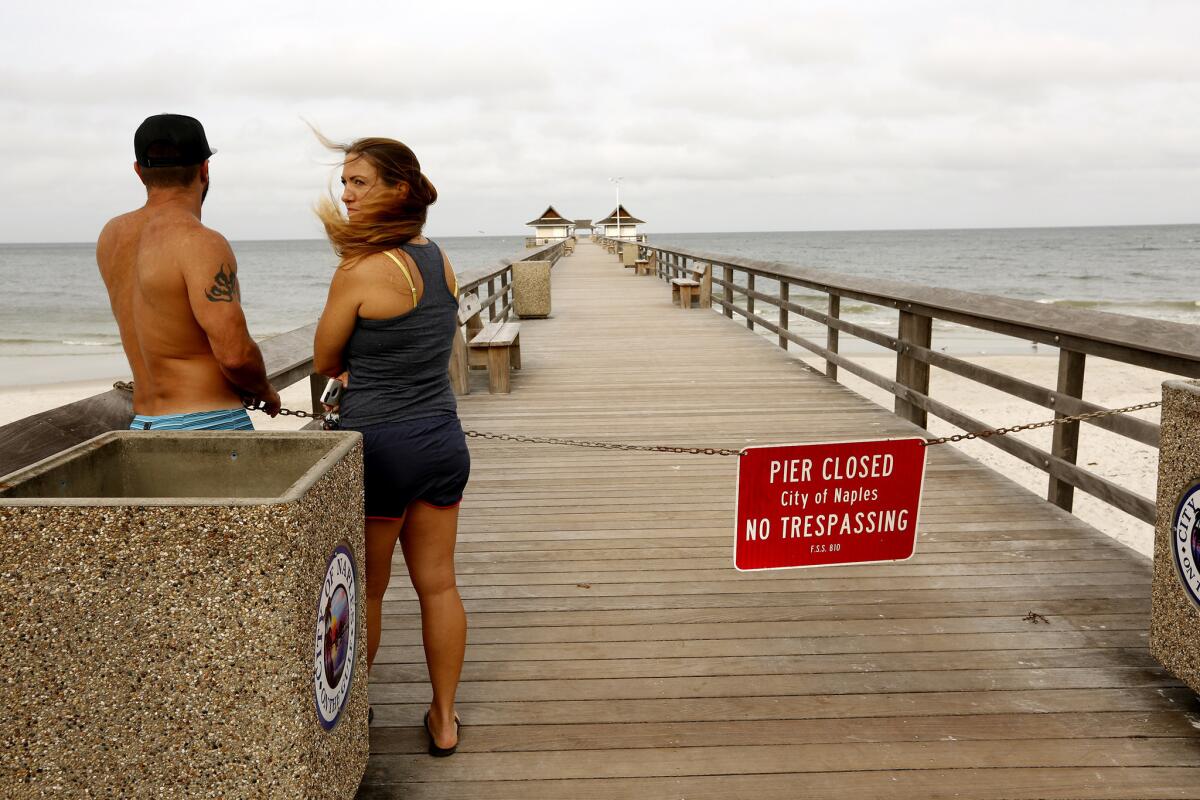
Underneath the historic pier near downtown Naples on Saturday morning, Katie Alvarez hugged her son Jordan and sobbed.
Hurricanes are part of an Alvarez family tradition. Katie Alvarez has photos of her kids on the pier before and after every major storm that has affected the coastal southwest Florida city. Sometimes they take phots during the storm. She was there Saturday to snap the before shots of her now-grown children.
Alvarez was in tears because she was certain there will be no photographs after the storm this year.
“It’s going to be gone,” said the Naples native, who joined her family at the beach in a homemade “Irma You Suck” shirt and visor with the Confederate flag emblazoned on it. She knows hurricanes, working at a company that installs storm shutters.
“I wanted to see it one last time,” Alvarez said of the pier, first built in 1888 but destroyed more than once by hurricanes over the years.
- Share via
Civil rights groups assail Florida sheriff’s decision to check for warrants at shelters
As Floridians cram into shelters all across the state, several civil rights groups are assailing one sheriff’s decision to ban those with outstanding warrants.
Polk County Sheriff Grady Judd announced earlier in the week that individuals with outstanding warrants won’t be allowed into shelters as Hurricane Irma pounds Florida. He said they should turn themselves into the local jail.
The move by Judd – whose county is about 55 miles east of Tampa – has created a firestorm of criticism from civil rights groups.
Officials from the Florida chapter of the National Assn. for the Advancement of Colored People said Saturday that Judd is “scaring people away from safe shelter,” which could lead to fatalities.
Earlier in the week the Florida branch of the American Civil Liberties Union said “most people with outstanding warrants are dealing with low-level and nonviolent offenses and pose no risk to others in a shelter.”
“Sheriff Judd’s threatening tweets send the message that these individuals must choose between facing a natural disaster without aid and shelter or going to jail over things like unpaid traffic tickets,” the group added.
As of early Saturday, no other counties in the state appear to be checking for warrants when admitting people into shelters.
Florida Gov. Rick Scott said Saturday that more than 300 shelters have been opened across the state and that about 54,000 people are staying in those shelters.
- Share via
People wait for hours to seek shelter in arena in southwest Florida